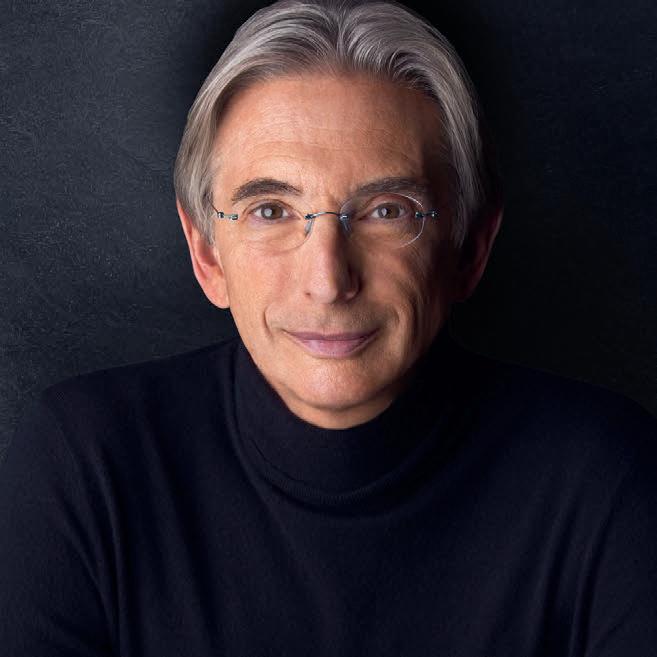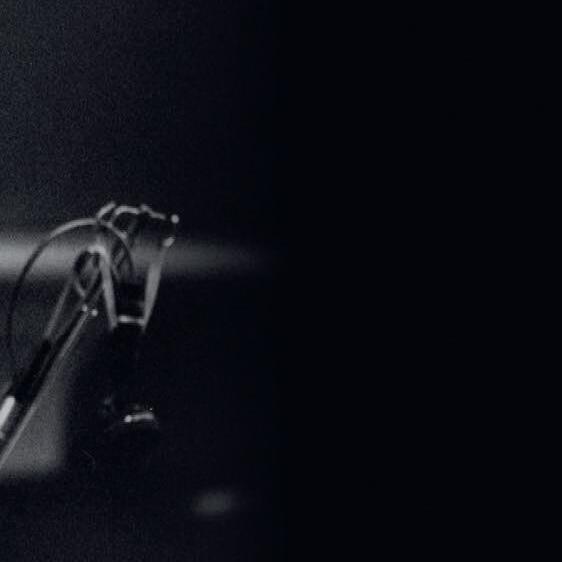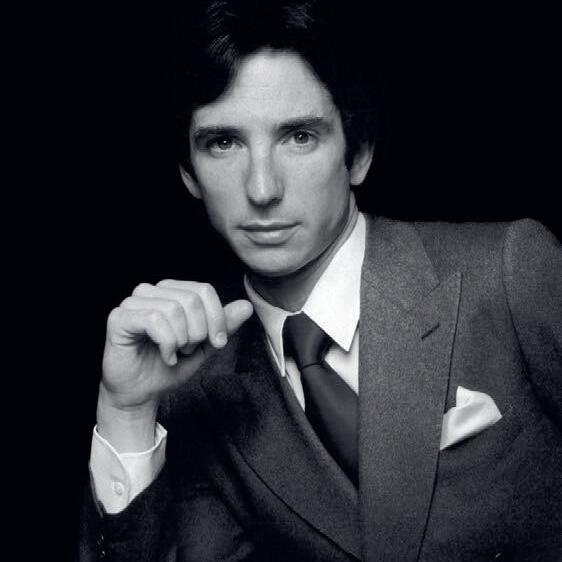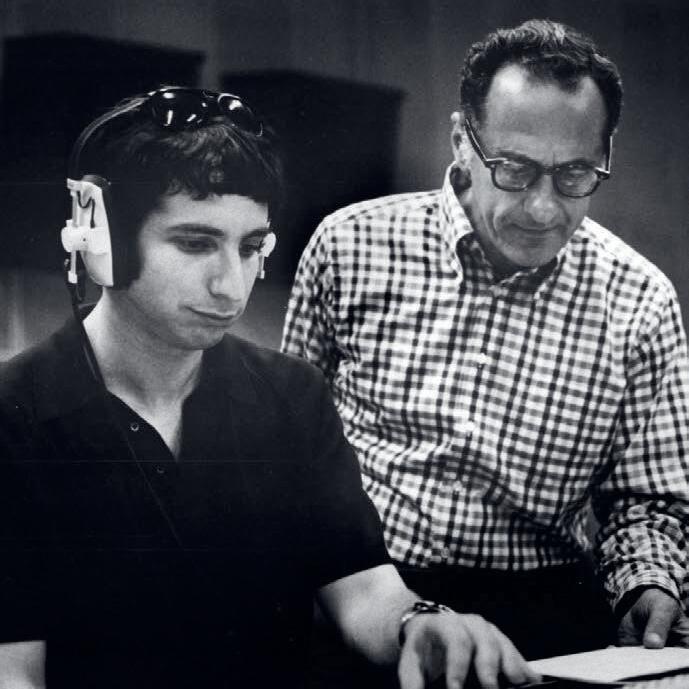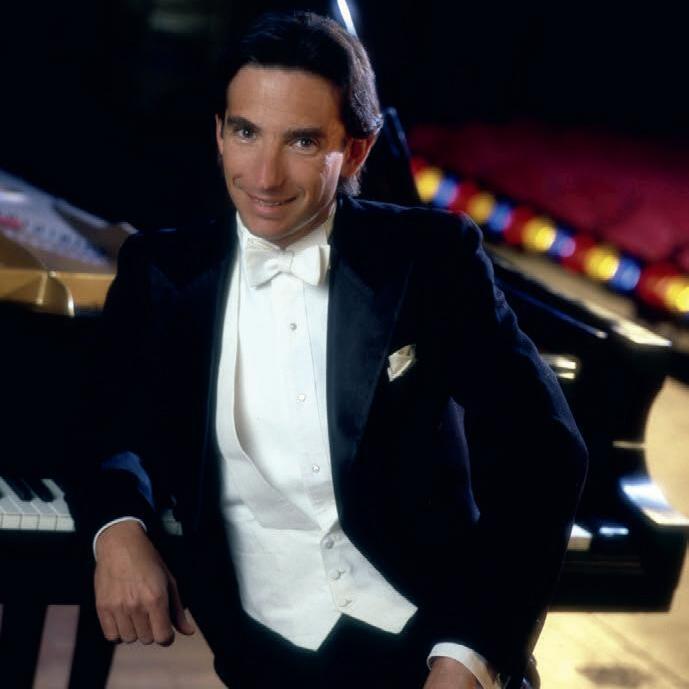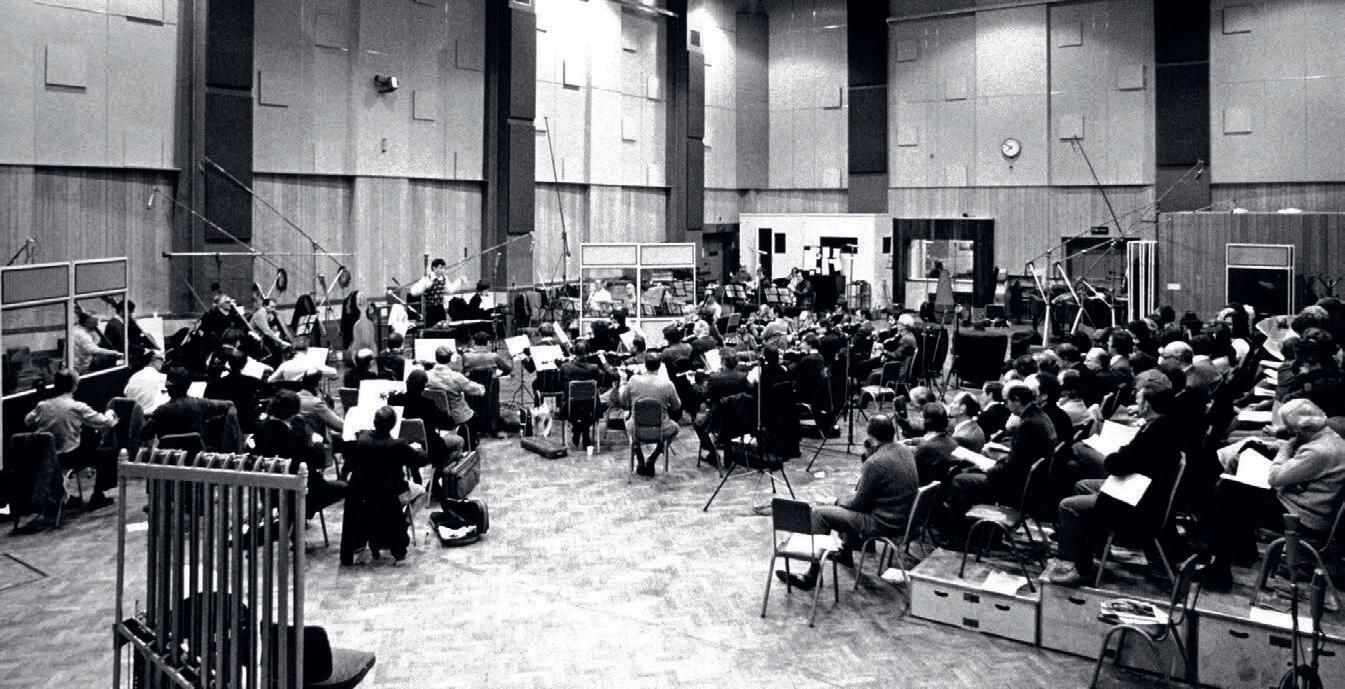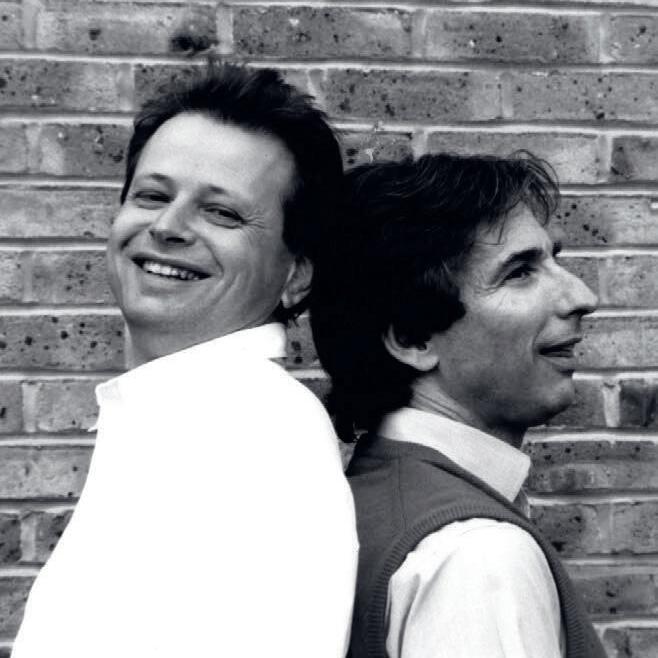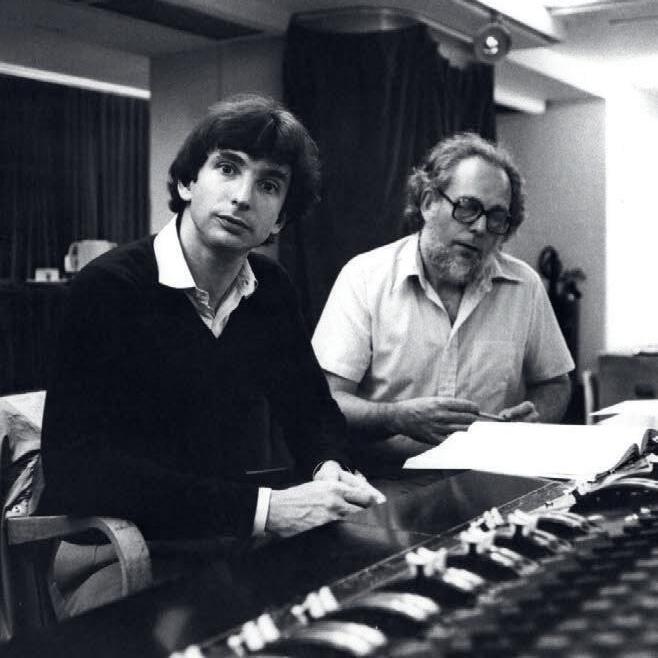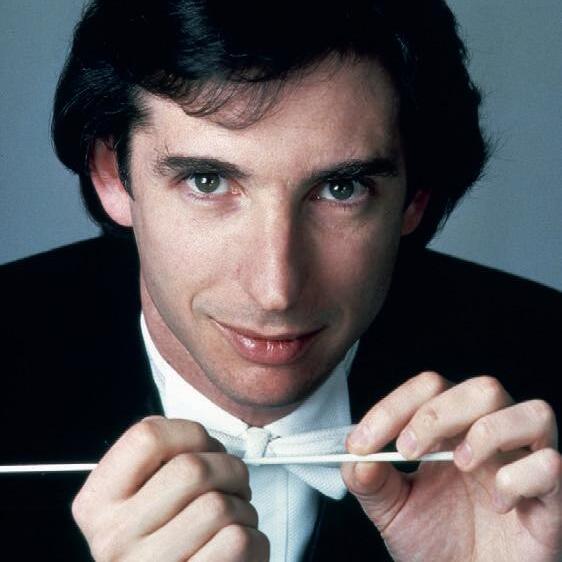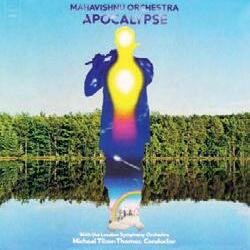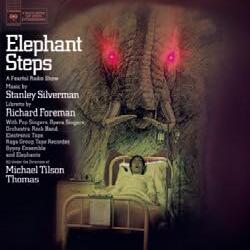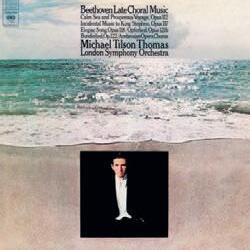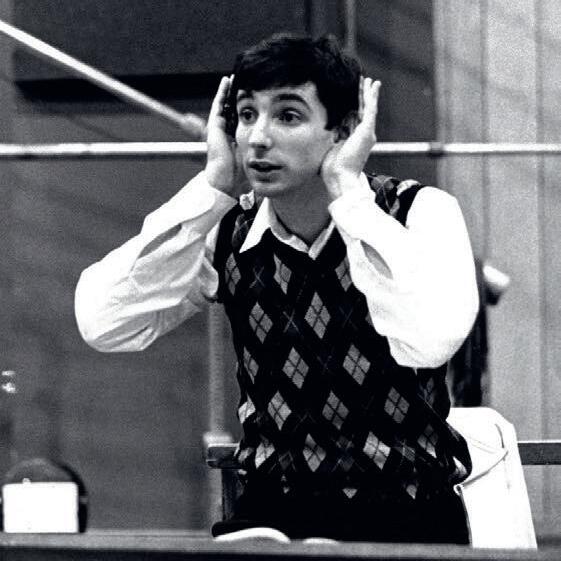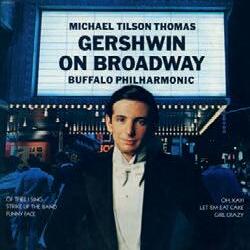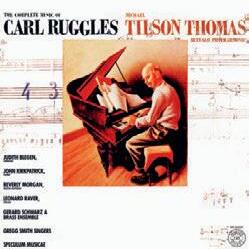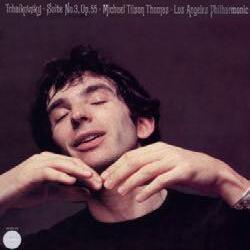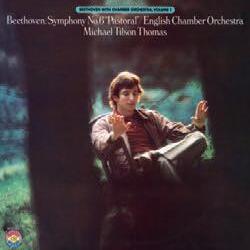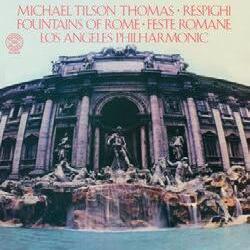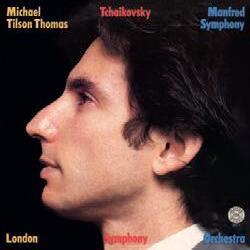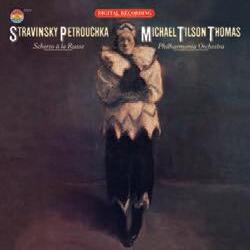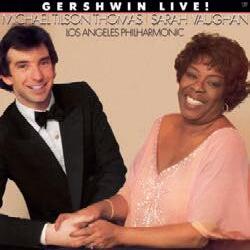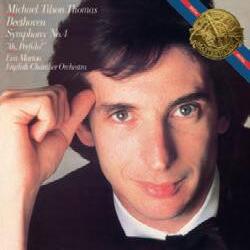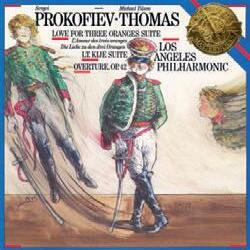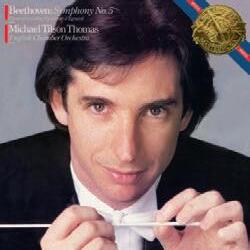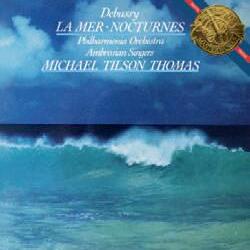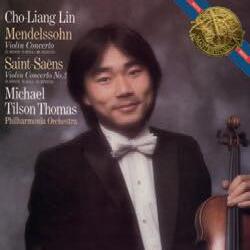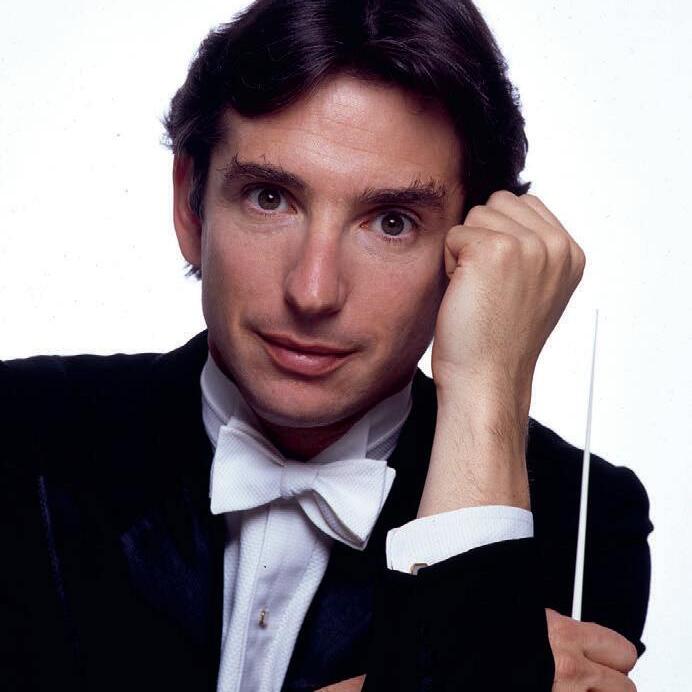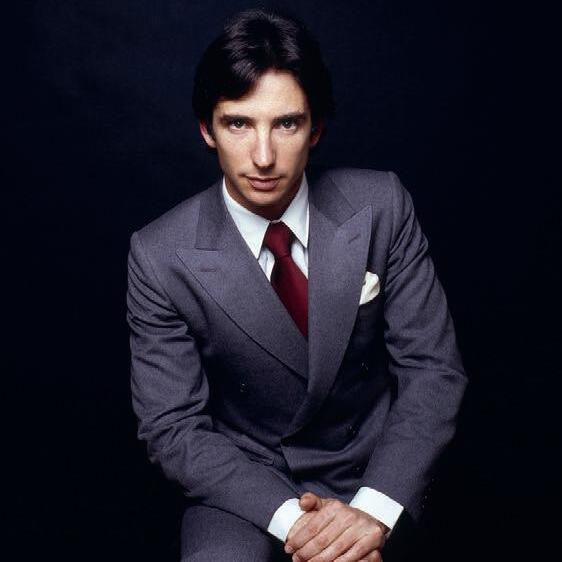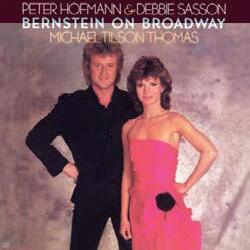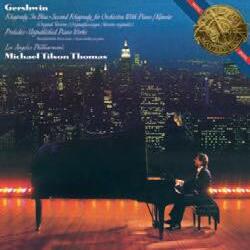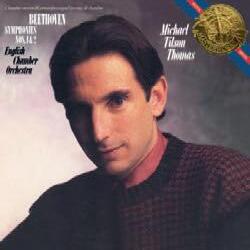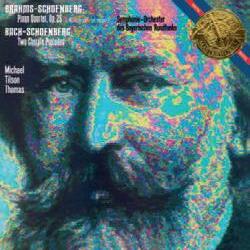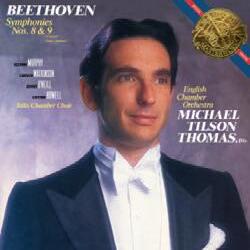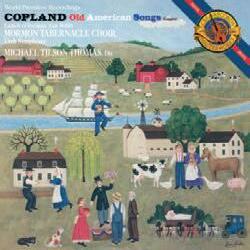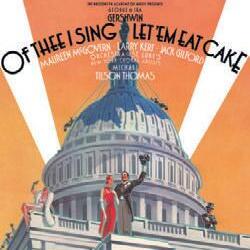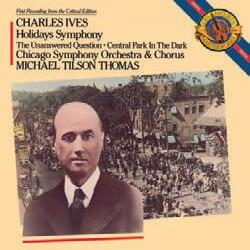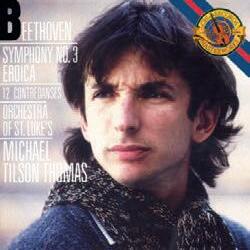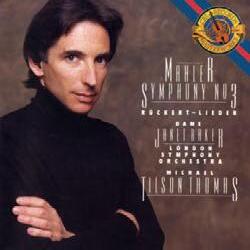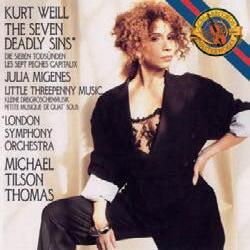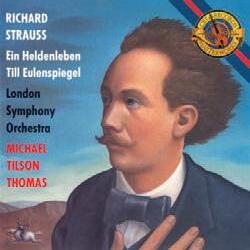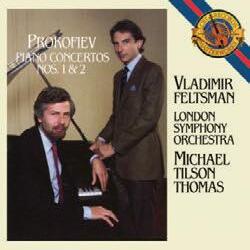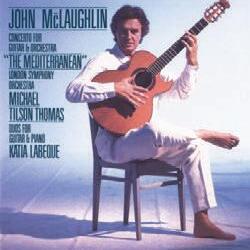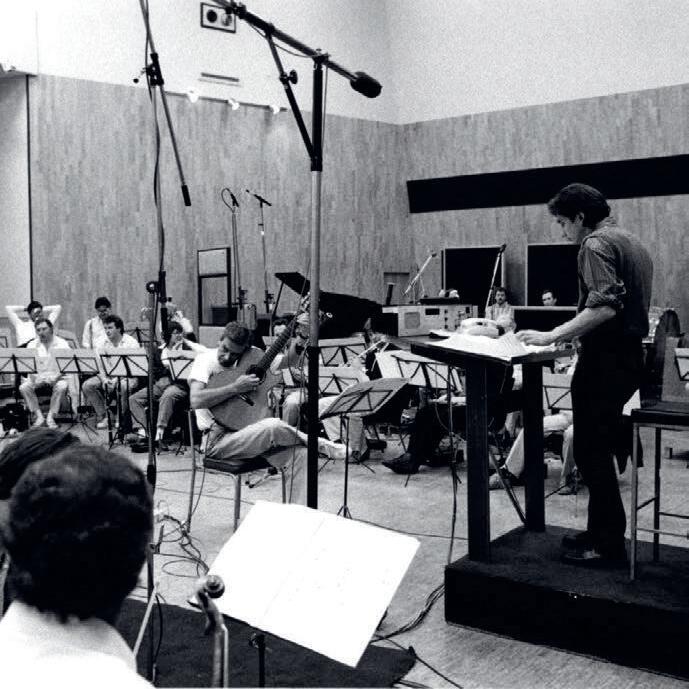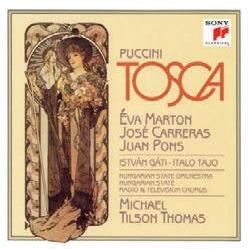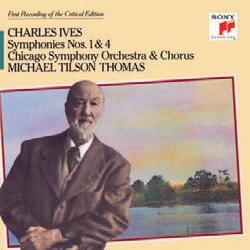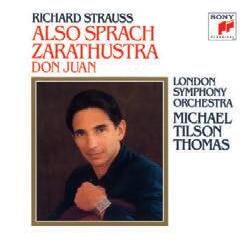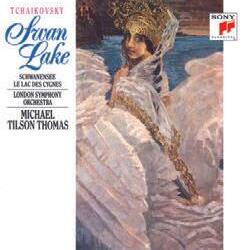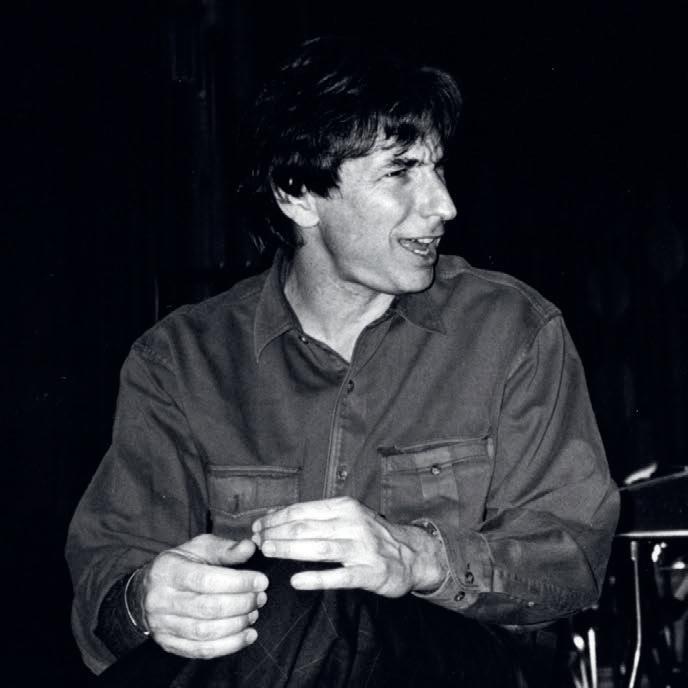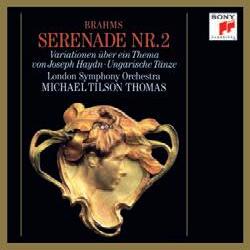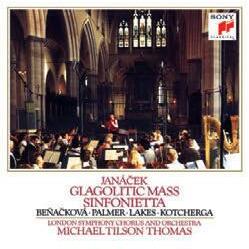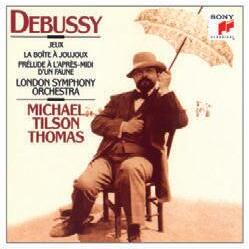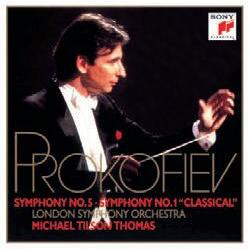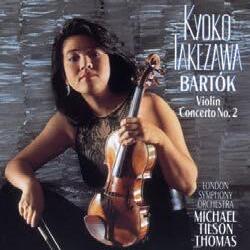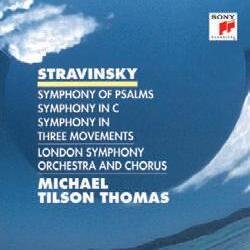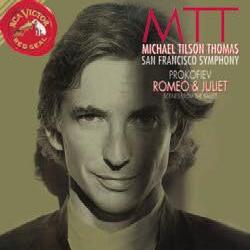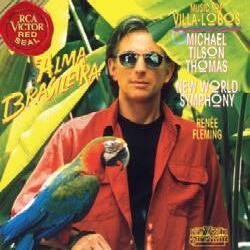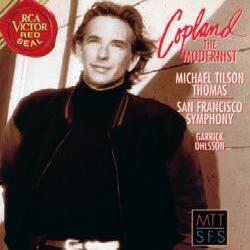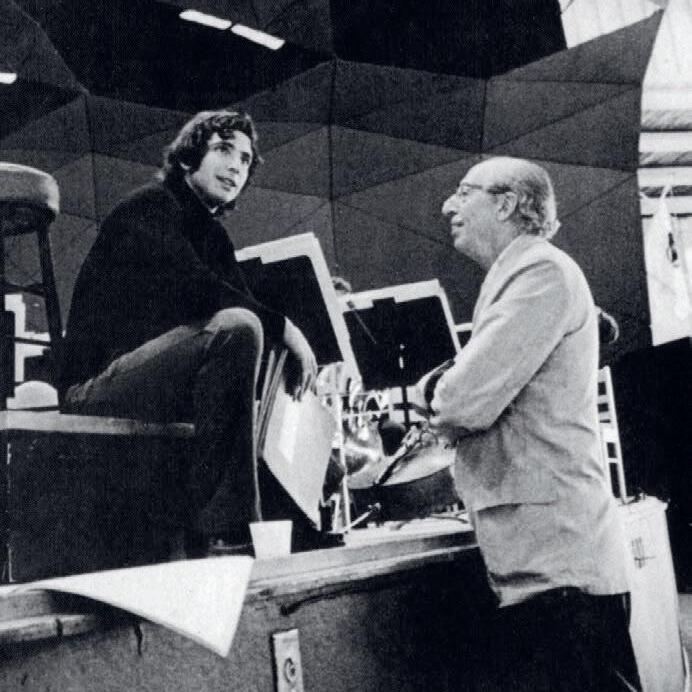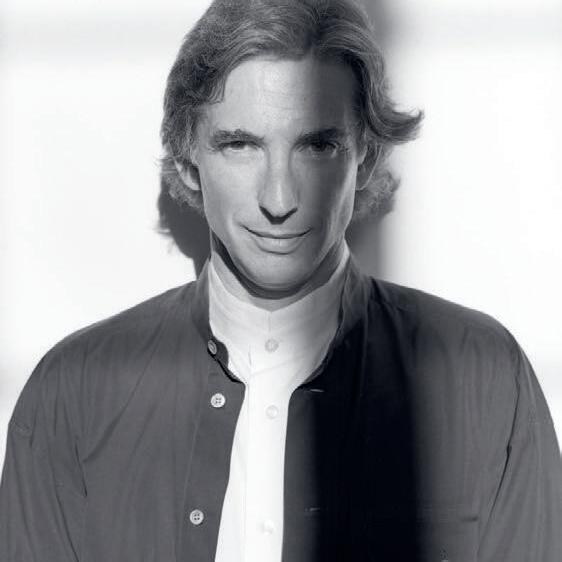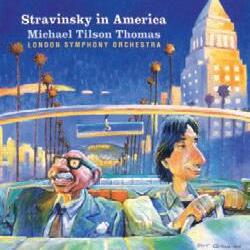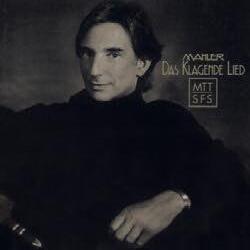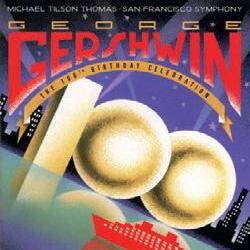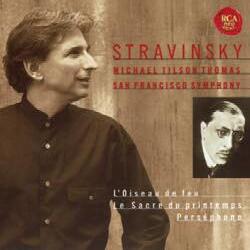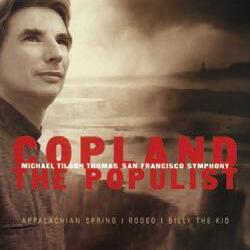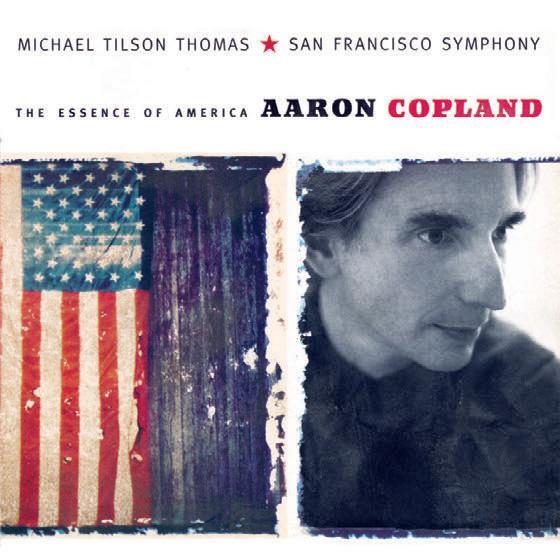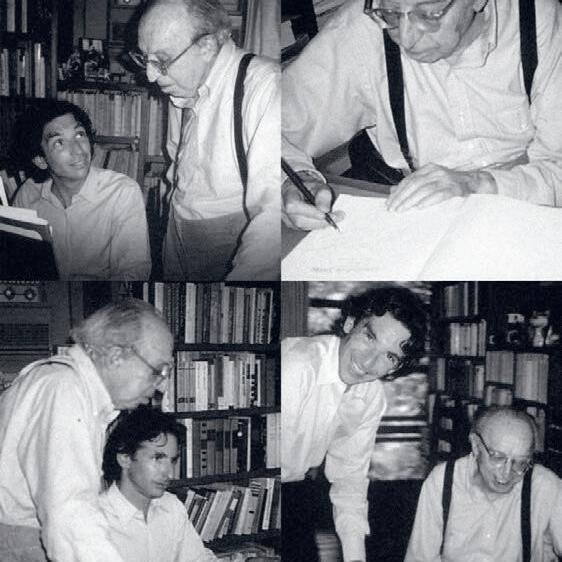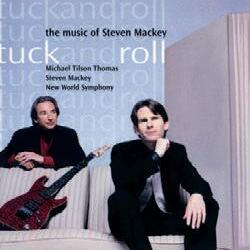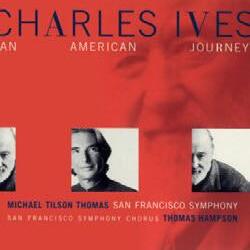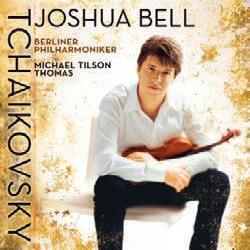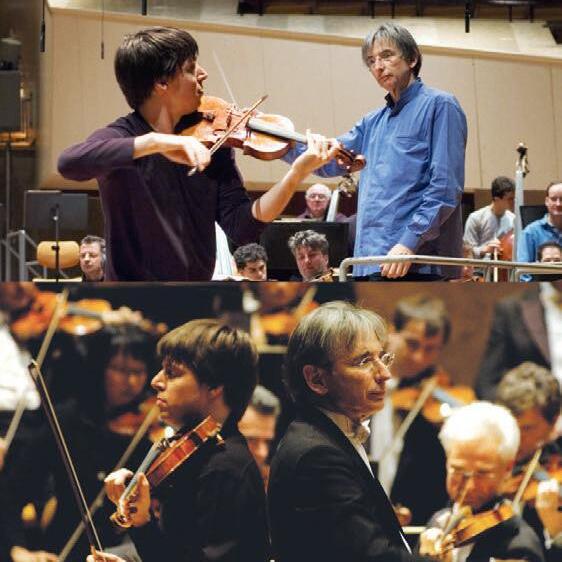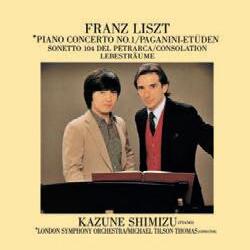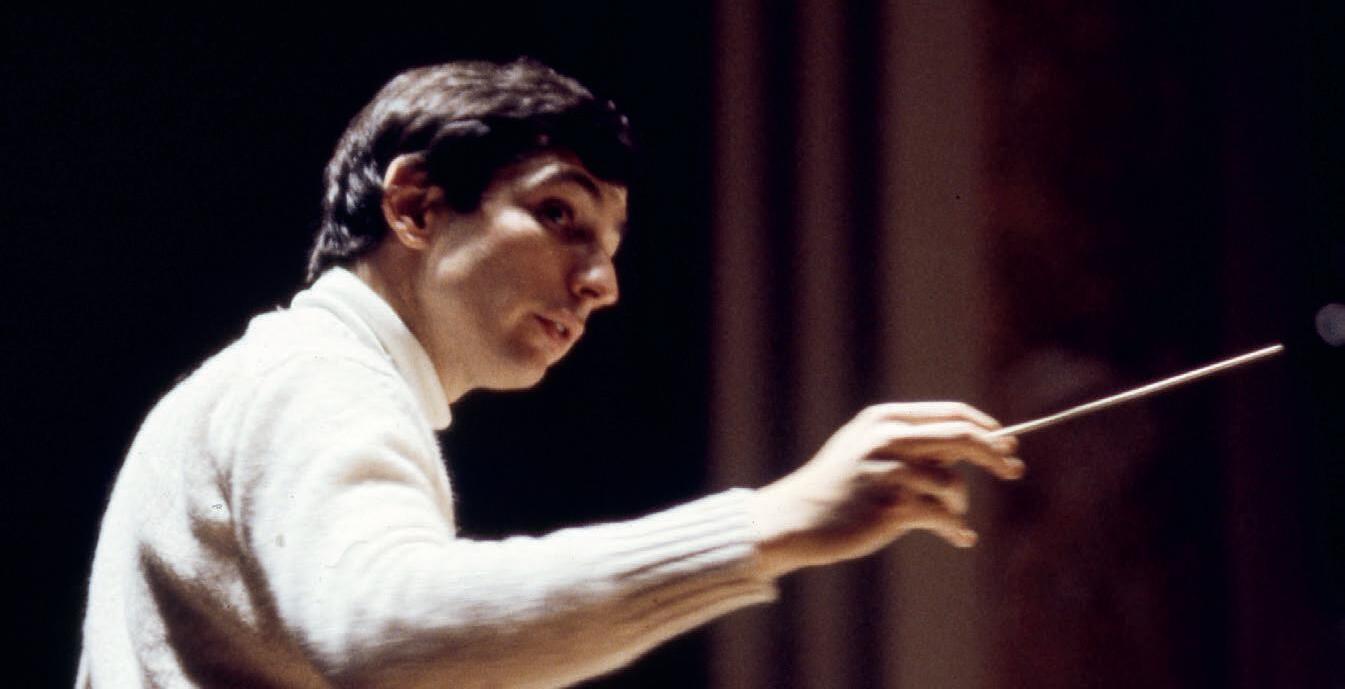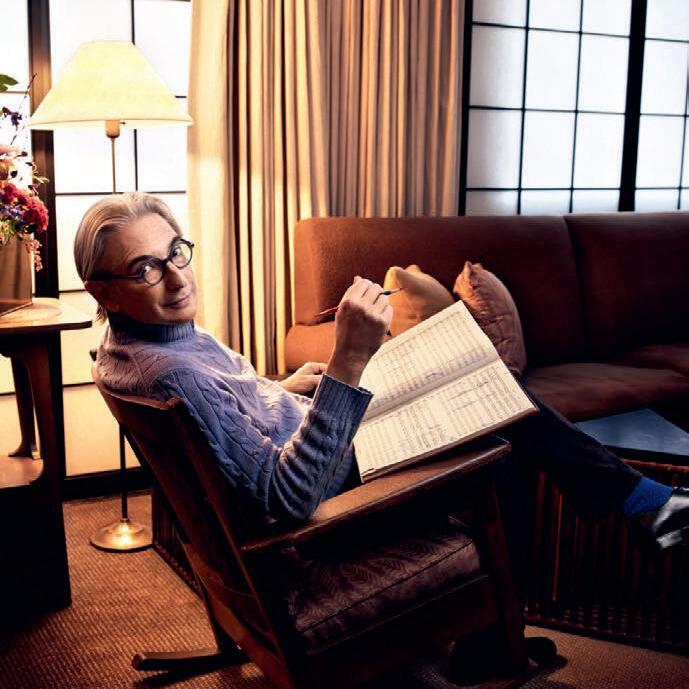Tracklists
Apocalypse
Orchestrations: Michael Gibbs
JOHN McLAUGHLIN *1942
1 Power of Love 4:17
2 Vision Is a Naked Sword 14:23
3 Smile of the Beyond 8:05
Text: Mahalakshmi
4 Wings of Karma 6:10
5 Hymn to Him 19:21
Mahavishnu Orchestra
Mahavishnu alias John McLaughlin
guitars · vocals
Jean-Luc Ponty electric violin · electric baritone violin
Carol Shive violin vocals
Marsha Westbrook viola
Philip Hirschl cello · vocals
Ralphe Armstrong bass · bass guitar · vocals
Michael Walden drums · percussion · vocals
Gayle Moran keyboards · vocals
London Symphony Orchestra
Michael Tilson Thomas conductor & pianist [2]
Original LP: C 32957 Released May 3, 1974
Recorded: London, Air Studios, March, 1974
Producer: George Martin
Recording Engineer: Geoffrey Emerick
LP Matrix Nos.: AL 32957 [1–3]; BL 32957 [4/5]
Publishers: Warner-Tamerlane / Chinmoy Music
P 1974 Sony Music Entertainment
5
6
Karen Altman scrubwoman
Susan Belling Hannah
Luther Enstad Max
Roland Gagnon Doctor
Larry Marshall Otto
Luther Rix Rock Singer
Marilyn Sokol Ragtime Lady
Philip Steele Hartman
Patti
June Magruder · Patricia Price
Albertine Robinson · Maeretha Stewart Rose Taylor
Producers:
Recording
Mix
CARL ORFF 1895–1982
Carmina Burana
Cantiones profanae cantoribus et choris cantandae comitantibus instrumentis atque imaginibus magicis
Songs from Benediktbeuern –
Secular songs for soloists and choir accompanied by instruments and stage pictures
FORTUNA IMPERATRIX MUNDI
1 No. 1: “O Fortuna” 2:26
2 No. 2: “Fortune plango vulnera” 2:44
I PRIMO VERE
3 No. 3: “Veris leta facies” 4:32
4 No. 4: “Omnia Sol temperat” 2:15
5 No. 5: “Ecce gratum” 2:29
UF DEM ANGER
6 No. 6: Dance 1:41
7 No. 7: “Floret silva nobilis” 3:03
8 No. 8: “Chramer, gip die varwe mir” 3:26
9 No. 9: Reie – 2:19
a “Swaz hie gat umbe” – 3:04
“Chume, chum, geselle min!” –
“Swaz hie gat umbe”
b No. 10: “Were diu werlt alle min” 0:49
Original LP: M/MQ 33172 Released February 1975
Recorded: Cleveland, Masonic Auditorium, August 5/6, 1974 & New York City, Columbia 30th Street Studio, September 4, 1974
Producer: Andrew Kazdin
Recording Engineer: Bud Graham & Ray Moore
LP Matrix Nos.: AL 33172 [1–12], BL 33172 [13–25]; QAL 33172 [1–12], QBL 33172 [13–25]
Publisher: European-American Music P 1975 Sony Music Entertainment
II IN TABERNA
c No. 11: “Estuans interius” 2:21
d No. 12: “Olim lacus colueram” 3:30
e No. 13: “Ego sum abbas” 1:46
f No. 14: “In taberna quando sumus” 2:58
III COUR D’AMOURS
g No. 15: “Amor volat undique” 4:08
h No. 16: “Dies, nox et omnia” 2:50
i No. 17: “Stetit puella” 1:51
j No. 18: “Circa mea pectora” 1:57
k No. 19: “Si puer cum puellula” 0:53
l No. 20: “Veni, veni, venias” 0:52
m No. 21: “In trutina” 2:36
n No. 22: “Tempus est iocundum” 2:19
o No. 23: “Dulcissime” 0:45
BLANZIFLOR ET HELENA
p No. 24: “Ave, formosissima” 2:01
FORTUNA IMPERATRIX MUNDI
q No. 25: “O Fortuna” 2:32
Judith Blegen soprano
Kenneth Riegel tenor
Peter Binder baritone
The Cleveland Orchestra Chorus
The Cleveland Orchestra Boys Choir
The Cleveland Orchestra
LUDWIG VAN BEETHOVEN 1770–1827
König Stephan op. 117 Music to August von Kotzebue’s Play
1 Overture. Andante con moto – Presto 6:49
2 Chorus: “Ruhend von seinen Taten” 2:11
3 Chorus: “Auf dunklem Irrweg in 1:14 finstern Hainen”
4 Siegesmarsch 3:40 Victory March
5 Chorus: “Wo die Unschuld Blumen 2:40 streute”
6 Chorus: “Eine neue strahlende Sonne” 0:40
7 Melodrama 1:12
8 Geistlicher Marsch 3:00 Priestly March
Chorus: “Heil unserm Könige”
9 Chorus: “Heil! Heil!” 2:15
a Elegischer Gesang op. 118 7:04
Text: Johann Christoph Friedrich Haug
b Opferlied op. 121b 7:48
Text: Friedrich von Matthisson
c Bundeslied op. 122 4:03
Text: Johann Wolfgang von Goethe
d Meeresstille und glückliche Fahrt 8:35
op. 112
The Ambrosian Singers John McCarthy chorus director London Symphony Orchestra
Sostenuto – Allegro vivace Original LP: M/MQ 33509 Released September 1975
Recorded: London, Abbey Road Studios, December 19–21, 1974
Producer: Paul Myers
Recording Engineers: Mike Ross-Trevor & Robert Gooch
LP Matrix Nos.: AL 33509 [1–9], BL 33509 [10–13]; QAL 33509 [1–9], QBL 33509 [10–13] P 1975 Sony Music Entertainment
CD 5 32:23
P 1976 Sony Music Entertainment Recording Beethoven, 1974
GEORGE GERSHWIN 1898–1937
1 Rhapsody in Blue 13:42
Original Version for Piano and Jazz Band
Orchestration: Ferde Grofé
George Gershwin piano (recorded with the 1925 Piano Roll)
Columbia Jazz Band
2 An American in Paris 18:34
New York Philharmonic
Original LP: M/MQ 34205 Released September, 1976
Recorded: New York, Columbia 30th Street Studio, June 23, 1976 [1]; New York City, Philharmonic Hall (now David Geffen Hall), February 11, 1974 [2]
Producer: Andrew Kazdin
Recording Engineers: Bud Graham, Milt Cherin & Ray Moore
LP Matrix Nos.: AL 34205 [1], BL 34205 [2]; QAL 34205 [1], QBL 34205 [2]
ANTONÍN DVOR ˇ ÁK 1841–1904
The American Flag op. 102
Cantata for Soloists, Chorus and Orchestra
Text: Joseph Rodman Drake
NO. 1: THE COLORS OF THE FLAG
1 “When Freedom from her 5:24 mountain-height” (chorus)
NO. 2: APOSTROPHE TO THE EAGLE
2 First Apostrophe to the Eagle: 1:36
“Majestic Monarch of the cloud!”
(bass solo, chorus)
3 Second Apostrophe to the Eagle: 1:36
“Child of the sun!”
(bass solo, chorus)
Original LP: M 34513 Released March 1977
Recorded: Berlin, Philharmonie, June 16/17, 1976
Producer: Paul Myers
Recording Engineers: Mike Ross-Trevor & Wolfgang Gülich
LP Matrix Nos.: AL 34513 [1–8], BL 34513 [9–13]
P 1977 Sony Music Entertainment
NO. 3: THREE APOSTROPHES TO THE FLAG.
4 Orchestral Interlude. Allegro giusto, 2:08 alla Marcia
5 First Apostrophe to the Flag 2:16 (The Foot-Soldier): “Flag of the brave!” (tenor, chorus)
6 Second Apostrophe to the Flag 2:21 (The Cavalryman): “And, when the cannon-mouthings loud” (bass, chorus)
7 Third Apostrophe to the Flag 2:35
The Sailor: Flag of the seas!” (chorus, bass)
FINALE (PROPHETIC)
8 “Flag of the free heart’s hope 2:32 and home” (bass, chorus)
Joseph Evans tenor Barry McDaniel bariton
RIAS Kammerchor
Chor der St.-Hedwigs-Kathedrale Berlin
Uwe Gronostay chorus director
Rundfunk-Sinfonieorchester Berlin
Music of Carl Ruggles
4
PYOTR ILYICH TCHAIKOVSKY 1840–1893
Orchestral Suite No. 3 in G major op. 55
1 I Élégie. Andante molto cantabile 10:30
2 II Valse mélancolique. 5:39
Allegro moderato
3 III Scherzo. Presto 4:47
4 IV Tema con variazioni. 19:39
Andante con moto –
Var. I –
Var. II. Molto più mosso –
Var. III. Tempo del Tema –
Var. IV. Tempo del Tema –
Var. V. Allegro risoluto –
Var. VI. Allegro vivace –
Var. VII. Moderato –
Var. VIII. Largo –
Var. IX. Allegro molto vivace –
Var. X. Allegro vivo e un poco rubato –
Var. XI. Moderato mosso –
Var. XII. Finale. Polacca.
Moderato assai – Allegro moderato –
Tempo di Polacca, molto brillante
Los Angeles Philharmonic Original LP: M 35124 Released May 1979
Recorded: Los Angeles, December 4, 1977
Producer: Steven Epstein
Recording Engineers: Bud Graham & Milton Cherin
LP Matrix Nos.: AL 35125 [1–3], BL 35124 [4]
LUDWIG VAN BEETHOVEN 1770–1827
Symphony No. 6 in F major “Pastoral” op. 68
1 I Erwachen heiterer Empfindungen 12:03 bei der Ankunft auf dem Lande.
Awakening of Cheerful Feelings upon Arrival in the Country Allegro ma non troppo
2 II Szene am Bach 12:18
Scene by the Brook Andante molto moto
3 III Lustiges Zusammensein 5:19 der Landleute
Merry Gathering of Country Folk Allegro
4 IV Gewitter, Sturm 3:07
Thunderstorm Allegro
5 V Hirtengesang. Frohe und dankbare 9:57
Gefühle nach dem Sturm
Shepherd’s Song. Happy and Thankful
Feelings after the Storm Allegretto
English Chamber Orchestra
Original LP: M 35169 Released November 1979
Recorded: London, Henry Wood Hall, October 16/17, 1978
Producer: Steven Epstein
Recording Engineers: Robert Auger & Milton Cherin
OTTORINO RESPIGHI 1879–1936
Feste romane
Roman Festivals · Symphonic Poem
1 I Circenses 4:26
Circuses
Moderato – Molto allegro
2 II Il giubileo 7:32
The Jubilee
Doloroso e stanco – Allegro moderato –
Allegro festoso
3 III L’Ottobrata 7:44
The October Festival
Allegro gicioso – Allegretto vivace –
Andante lento ed espressivo
4 IV La Befana 4:56
Epiphany
Vivo – Vivacissimo
Original LP: M 35846 Released August 1980
Recorded: Los Angeles, UCLA, Royce Hall, December 22/23, 1978
Producer: Steven Epstein
Recording Engineer: Bud Graham LP Matrix Nos.: AL 35846 [1–4], BL 35846 [5–8] P 1980 Sony Music Entertainment
Fontane di Roma
The Fountains of Rome · Symphonic Poem
5 I La fontana di Valle Giulia all’alba 4:39
The Giulia Valley Fountain at Daybreak Andante mosso
6 II La fontana del Tritone al mattino 2:26
The Triton Fountain in the Morning Vivo
7 III La fontana di Trevi al meriggio 3:15
The Trevi Fountain at Midday
Allegro moderato – Allegro vivace –Largamente – Calmo
8 IV La fontana di Villa Medici al tramonto 6:06
The Villa Medici Fountain at Sunset Andante
Los Angeles Philharmonic
PYOTR ILYICH TCHAIKOVSKY 1840–1893
Manfred op. 58
Symphony in B minor in Four Scenes after the Dramatic Poem by Lord Byron
1 I Lento lugubre 16:18
2 II Vivace con spirito 9:35
3 III Andante con moto 10:26
4 IV Allegro con fuoco 18:53
London Symphony Orchestra
Recorded: London, Abbey Road Studios, June 4/5, 1979
Producer: Steven Epstein
Recording Engineers: Arthur Kendy & Robert Gooch
LP Matrix Nos.: AL 36673 [1/2], BL 36673 [3/4]
PYOTR ILYICH TCHAIKOVSKY 1840–1893
Orchestral Suite No. 2 in C major “Suite caractéristique” op. 53
1 I Jeu de sons 11:15
Play of Sounds
Andantino un poco rubato –
Allegro molto vivace
2 II Valse 5:49
Waltz
Moderato. Tempo di valse
3 III Scherzo burlesque 5:10
Vivace, con spirito
4 IV Rêves d’enfant 10:01
Children’s Dreams
Andante molto sostenuto
5 V Danse baroque (style Dargomyjski) 3:54
Baroque Dance (in the style of Dargomyzhsky)
Vivacissimo – Prestissimo
Philharmonia Orchestra
Original LP: IM 36702 Released December 1981
Recorded: London, Abbey Road Studios, May 30, 1980 [1–4]; June 1, 1980 [6–8]
Producer: Steven Epstein
Recording Engineers: Bud Graham & Neville Boyling
Matrix Nos.: DAL 36702 [1–4], DBL 36702 [5–9]
Orchestral Suite No. 4 in G major
“Mozartiana” op. 61
6 I Gigue 1:35 after Mozart’s Eine kleine Gigue for Piano K 574 Allegro
7 II Menuet 3:56 after Mozart’s Minuet for Piano K 355 Moderato
8 III Preghiera. Andante non tanto 4:31 after Liszt’s Piano Transcription of Mozart’s Ave verum corpus for Chorus, Strings and Organ K 618)
9 IV Thème et variations 13:09 after Mozart’s 10 Variations for Piano K 455 on the Theme “Unser dummer Pöbel meint” by Christoph Willibald Gluck Allegro giusto
Carl Pini solo violin Philharmonia Orchestra
IGOR STRAVINSKY 1882–1971
Pétrouchka
Burlesque in 4 Scenes
1946/47 Version SCENE 1
Fête populaire de la semaine grasse 5:33
The Shrovetide Fair 2 Le Tour de passe-passe 1:59 The Magic Trick 3 Danse russe 2:45 Russian Dance
Pétrouchka
Danse de la Ballerine 0:42 Dance of the Ballerina
Valse. La Ballerine et le Maure 3:19 Waltz. The Ballerina and the Moor Original LPs: IM 37271 Released March 1982
Recorded: London, Abbey Road Studios, Studio 1, November 19/20, 1980
Producer: Steven Epstein
Recording Engineers: Bud Graham & Neville Boyling
Publisher: Boosey & Hawkes
4
8 Fête populaire de la semaine 1:04
grasse (vers le soir)
The Shrovetide Fair (toward evening)
9 Danse des nounous 2:37
The Wet Nurses’ Dance
a Le Paysan et l’ours 1:29
The Peasant and the Bear
b Un marchand fêtard avec deux 1:13
tziganes
The Jovial Merchant with Two Gypsy Girls
c Danse des cochers et des palefreniers 2:21
Dance of the Coachmen and the Grooms
d Les Déguisés 1:34
The Masqueraders
e La Rixe. Le Maure et Pétrouchka 0:48
The Fight. The Moor and Petrushka
f Mort de Pétrouchka 0:52
Death of Petrushka
g La Police et le Charlatan 1:27
The Police and the Juggler
h Apparition du double de Pétrouchka 0:54
Apparition of Petrushka’s Double
Vivian Troon piano
i Scherzo à la russe 3:54
Symphonic Version
Philharmonia Orchestra
Michael Tilson Thomas conductor
Gershwin Live!
GEORGE GERSHWIN 1898–1937
Medley from Porgy and Bess
Text: Ira Gershwin & DuBose Heyward
Arrangement: Marty Paich
1 Introduction – Summertime – 7:52
It Ain’t Necessarily So – I Loves You, Porgy
Medley
Text: Ira Gershwin
Arrangement: Marty Paich & Michael Tilson Thomas
2 But Not for Me from Girl Crazy – 9:39
Love Is Here to Stay from the Film
The Goldwyn Follies – Embraceable You –
Someone to Watch Over Me from Oh, Kay!
3 Sweet and Low-Down 3:36 from Tip-Toes
Text: Ira Gershwin
4 Fascinating Rhythm 4:04 from Lady, Be Good!
Text: Ira Gershwin
Arrangement: Marty Paich
5 Do It Again! 5:24 from The French Doll
Text: B.G. DeSylva
Recorded: Los Angeles, Dorothy Chandler Auditorium, February 1/2, 1982
Producer: Steven Epstein Recording Engineer: Bud Graham
6 My Man’s Gone Now 5:52 from Porgy and Bess
Text: Ira Gershwin & DuBose Heyward
7 The Man I Love 10:03 from Strike Up the Band
Text: Ira Gershwin
Arrangement: Marty Paich
Medley
Text: Ira Gershwin · Irving Caesar*
Arrangement: Marty Paich
8 Nice Work If You Can Get It 6:57 from the Film A Damsel in Distress –They Can’t Take That Away from Me from the Film Shall We Dance –
’S Wonderful from Funny Face –Swanee* –
Strike Up the Band from Strike Up the Band
ENCORE
Medley
Lyrics: Ira Gershwin
Arrangement: Marty Paich
9 I’ve Got a Crush on You from Treasure Girl 7:34 and Strike Up the Band – A Foggy Day from the Film A Damsel in Distress
Sarah Vaughan vocals
Harold Jones drums [1/2/4/6–9]
George Gaffney piano [1/2/4/6–9]
Andy Simpkins bass [1/2/4/6–9]
Los Angeles Philharmonic
Michael Tilson Thomas pianist [3/5/7] & conductor
CD 17 48:25
LUDWIG VAN BEETHOVEN (1770–1827)
Symphony No. 4 in B-flat major op. 60
1 I Adagio – Allegro vivace 12:18
2 II Adagio 9:52
3 III Allegro vivace – 6:05 Trio. Un poco meno Allegro
4 IV Allegro ma non troppo 6:32
5 “Ah! perfido!” op. 65 13:26
Scene and Aria for Soprano and Orchestra
Text: Pietro Metastasio (Part 1) Allegro con brio – Aria. Adagio
Eva Marton soprano
English Chamber Orchestra Original LP: IM 37209 Released September 1982
Recorded: London, Abbey Road Studios, October 19/21, 1980 [1–4]; April 3, 1982
Producer: Steven Epstein
Recording Engineer: Neville Boyling LP Matrix Nos.: DAL 37209 [1–3], DBL 37209 [4/5] P 1982 Sony Music Entertainment
18 37:49
IVES 1874–1954
Symphony No. 2
1 I Andante moderato – 5:47
2 II Allegro 11:11
5 V Allegro molto vivace 9:42
Concertgebouworkest Amsterdam
LP: IM 37300 Released October 1982
Recorded: Amsterdam, Concertgebouw, August 24/25, 1981
Producer: David Mottley
Recording Engineer: Michael Gray
LP Matrix Nos.: DAL 37300 [1/2], DBL 37300 [3–5]
Publisher: Southern Music Publishing
SERGEI PROKOFIEV 1891–1953
Lieutenant Kijé Suite op. 60
1 I Kijé’s Birth 4:06
Andante assai
2 II Romance 4:48
Andante – Allegretto (Poco meno del doppio movimento) – Tempo I
3 III Kijé’s Wedding 2:48
Allegro festoso
4 IV Troïka 2:45
Moderato – Allegro con brio
5 V Kijé’s Burial 5:57
Andante assai – Allegro moderato
L’Amour des trois oranges –
Orchestral Suite op. 33a
The Love for Three Oranges
6 I Les Ridicules 2:49
The Clowns Vivo
7 II Le Magicien Tchélio et 3:01
Fata Morgana jouent aux cartes (Scène infernale)
The Magician Tchelio and Fata Morgana
Play Cards (Infernal Scene)
Allegro moderato
8 III Marche 1:30 Tempo di marcia
Original LP: M 36683 Released April 1983
Recorded: Los Angeles, UCLA, Royce Hall, December 23, 1978 [1–11]; Los Angeles, Dorothy Chandler Pavilion, February 6, 1982 [12]
Producer: Steven Epstein
Recording Engineer: Arthur Kendy & Bud Graham
Matrix Nos.: AL 36683 [1–5], BL 36683 [6–12]
1983 Sony Music Entertainment
9 IV Scherzo 1:23 Allegro con brio a V Le Prince et la princesse 4:04 The Prince and the Princess Andantino
LUDWIG VAN BEETHOVEN 1770–1827
Symphony No. 5 in C minor op. 67
1 I Allegro con brio 7:49
2 II Andante con moto 9:45
3 III Allegro – 4:49 attacca
4 IV Allegro 11:02
5 Egmont Overture op. 84 8:30 from the Music to Johann Wolfgang von Goethe’s Tragedy Sostenuto, ma non troppo – Allegro
La Mer L 109
3 Symphonic Sketches
1 I De l’aube à midi sur la mer 9:24
From Dawn to Midday on the Sea
Très lent
2 II Jeux de vagues 7:18
Play of the Waves
Allegro
3 III Dialogue du vent et de la mer 8:11
Dialogue of the Wind and the Sea
Animé et tumultueux
Nocturnes L 91
Symphonic Triptych for Orchestra and Choirs
4 Nuages 8:42
Clouds
Modéré – Un peu animé
5 Fêtes 6:25
Celebrations
Animé et très rythmé – De plus en plus sonore et en serrant le mouvement
6 Sirènes 12:18
Mermaids
Modérément animé
Original LP: IM 37832 Released August 1983
Ambrosian Singers [6]
John McCarthy chorus master
Philharmonia Orchestra
Recorded: London, Abbey Road Studios, Studio 1, May 4/5, 1982
Producer: David Mottley
Recording Engineer: Michael Gray
LP Matrix Nos.: DAL 37832 [1–3], DBL 37832 [4–6]
P 1983 Sony Music Entertainment
CD 22 58:35
FELIX MENDELSSOHN 1809–1847
Concerto for Violin and Orchestra in E minor op. 64
1 I Allegro molto appassionato – 13:29
attacca
2 II Andante – 8:23
attacca
3 III Allegretto non troppo – 6:44 Allegro molto vivace
CAMILLE SAINT-SAËNS 1835–1921
Concerto for Violin and Orchestra No. 3 in B minor op. 61
4 I Allegro non troppo 9:37
5 II Andantino quasi allegretto 8:49
6 III Molto moderato e maestoso – 11:27 Allegro non troppo – Più allegro
Cho-Liang Lin violin Philharmonia Orchestra
Original LP: IM 39007 Released January 1984
Recorded: London, Abbey Road Studios, October 26, 1982 [1–3]; October 27, 1982 [4–6]
Producer: Steven Epstein
Recording Engineers: Dane Brewer, Martha de Francisco & Peter Bown
[1–3],
[4–6]
I Poco sostenuto – Vivace 15:11
II Allegretto 8:24
English Chamber Orchestra
Original LP: M 39052 Released September 1984 (digital recording with M instead of IM prefix)
Recorded: London, Abbey Road Studios, March 31 & April 1, 1982
Producer: Steven Epstein
Recording Engineers: Bud Graham & Neville Boyling
LP Matrix Nos.: DAL 39052 [1/2], DBL 39052 [3/4] P 1984 Sony Music Entertainment
CHARLES IVES 1874–1954
Symphony No. 3 “The Camp Meeting”
1 I Old Folks Gatherin’ 8:00 Andante maestoso
2 II Children’s Day 6:46 Allegro
3 III Communion 8:21 Largo
Concertgebouw Chorus
Geert van Keulen director
Original LP: IM 37823 Released January 1985
Orchestral Set No. 2
4 I An Elegy to Our Forefathers 5:44 Very slowly
5 II The Rockstrewn Hills Join in 4:47 the People’s Outdoor Meeting Allegro
6 III From Hanover Square North, 9:55 at the End of a Tragic Day, the Voice of the People Again Arose. Very slowly – Andante maestoso
Concertgebouworkest Amsterdam
Recorded: Amsterdam, Concertgebouw, May 10, 1982 [1–3]; April 19, 1982 [4–6]
Producer: David Mottley
Recording Engineer: Michael Gray
LP Matrix Nos.: DAL 37823 [1–3], DBL 37823 [4–6]
Publishers: Associated Music Publishers [1–3]; Peermusic Classical [4–6]
P 1985 Sony Music Entertainment
Excerpts from the Musical in 2 Acts
Based on a Conception of Jerome Robbins
Book: Arthur Laurents · Lyrics: Stephen Sondheim
Orchestration: Leonard Bernstein,
Sid Ramin & Irwin Kostal
On the Town
Excerpts from the Musical Comedy in 2 Acts
Based on an idea of Jerome Robbins
Book & Lyrics: Betty Comden & Adolph Green
Additional Text: Leonard Bernstein
Orchestrations: Hershy Kay, Don Walker, Elliott Jacoby, Ted Royal, Bruce Coughlin & Leonard Bernstein
9 Ballet: The Imaginary Coney Island: 3:47
a) Subway Ride
a Some Other Time 4:21
Mass
Excerpts from the Theater Piece for Singers, Players and Dancers
Text from the liturgy of the Roman Mass
Additional Texts: Stephen Schwartz & Leonard Bernstein I
b No. 2: Hymn and Psalm: 4:51 A Simple Song
Deborah Sasson soprano
Peter Hofmann tenor
Members of the Los Angeles Philharmonic
Recorded: Los Angeles, RCA Studio A, June 20/21, 1984 & Munich, Unions Studio, October 17/18, 1984
Producer: Steven Epstein
LP Matrix Nos.: AL 39535 [1–6], BL 39535 [7–12]
Publishers: Universal-Polygram International [1–12]; Chappell [1–8]
P 1985 Sony Music Entertainment
c Communion (Secret Songs) 5:54
GEORGE GERSHWIN 1898–1937
1 Rhapsody in Blue 15:49 for Piano and Orchestra
Orchestration: Ferde Grofé
Lorin Levee clarinet
Los Angeles Philharmonic
Michael Tilson Thomas conductor & piano
2 3 Preludes for Piano 7:15
No. 1: Allegro ben ritmato e deciso
No. 2: Andante con moto e poco rubato
No. 3: Allegro ben ritmato e deciso
3 Short Story 2:56
Reconstruction: Michael Tilson Thomas
4 Violin Piece 3:47
Gershwin Melody No. 40
Arrangement: Michael Tilson Thomas
Michael Tilson Thomas piano
Original LP: IM 39699 Released May 1985
5 Second Rhapsody 14:15 for Orchestra with Piano Original Version
Los Angeles Philharmonic
Michael Tilson Thomas conductor & piano
6 For Lily Pons 2:03
Gershwin Melody No. 79
Realization: Michael Tilson Thomas
7 Sleepless Night 4:30
Gershwin Melody No. 17
Michael Tilson Thomas piano
8 Promenade (“Walking the Dog”) 2:56
Los Angeles Philharmonic
Michael Tilson Thomas conductor & piano
Recorded: Los Angeles, Dorothy Chandler Pavillion, February 5, 1982 [1]; October 21, 1983 [5/8]; New York City, RCA Studio A, March 19-21, 1984 [2–4/6/7]
Producer: Steven Epstein
Recording Engineers: Bud Graham [1/5/8]; Tim Geelan [2–5/6/7]
LP Matrix Nos.: DAL 39699 [1–4], DBL 39699 [5–8]
Publishers: Warner Bros. Music [1–7]; New World Music [1/2–7]; Chappell [8]
P 1985 Sony Music Entertainment
1 I Adagio molto – Allegro con brio 12:55
2 II Larghetto 12:35
3 III Scherzo. Allegro – Trio 3:34
4 IV Allegro molto 6:12 Symphony No. 1 in C
5 I Adagio molto – Allegro con brio 9:39
6 II Andante cantabile con moto 8:28
7 III Menuetto. Allegro molto e vivace
8 IV Finale. Adagio – 5:48
Allegro molto e vivace
English Chamber Orchestra
Original LP: IM 39707 Released February 1986
Recorded: London, Abbey Road Studios, December 18/19, 1982 [1–4]; September 12, 1982 [5–8]
Producer: Steven Epstein
Recording Engineer: Neville Boyling
[1–4],
CD 28 46:59
JOHANNES BRAHMS 1833–1897
Quartet for Piano, Violin, Viola and Cello No. 1 in G minor op. 25
Orchestration: Arnold Schoenberg
1 I Allegro – Animato – Tranquillo 13:53
2 II Intermezzo. Allegro ma non troppo – 7:41
Trio. Animato – Coda
3 III Andante con moto – Animato 9:52
4 IV Rondo alla zingarese. Presto – 8:16
Meno presto – Kadenz –
Meno presto – Poco più presto –
Molto presto
JOHANN SEBASTIAN BACH 1685–1750
5 Schmücke dich, o liebe Seele BWV 654 4:58
Chorale Prelude
Orchestration: Arnold Schoenberg
Werner Thomas cello
6 Komm, Gott Schöpfer, heiliger Geist 2:19
BWV 631
Chorale Prelude
Orchestration: Arnold Schoenberg
Symphonieorchester des Bayerischen Rundfunks
Original LP: IM 42129 Released May 1986
Recorded: Munich, Herculessal, February 6–8, 1985
Producer: David Mottley
Recording Engineer: Martin Wöhr
LP Matrix Nos.: DAL 42129 [1/2], DBL
LUDWIG VAN BEETHOVEN 1770–1827
Symphony
Original LPs: M2 39711 (M 39712/13) Released March 1987 (digital recording with M instead of IM prefix)
Recorded: London, Abbey Road, EMI Studios, November 24/25, 1985 [CD 29]; May 15, 1983, September 9/10, 1983 & November 26, 1984 [CD 30]
Producer: Steven Epstein
Recording Engineer: Neville Boyling
LP Matrix Nos.: DAL 39712 [CD 29], DBL 39712 [CD 30: 1], DAL 39713 [CD 30: 2/3], DBL 39713 [CD 30: 4]
6:30
Recitativo: “O Freunde, nicht 17:10 diese Töne!” – Allegro assai –Allegro assai vivace. Alla Marcia –Andante maestoso – Adagio ma non troppo ma divoto – Allegro energico, sempre ben marcato – Allegro ma non tanto – Poco adagio – Prestissimo Final chorus from Schiller’s ode “To Joy”
Suzanne Murphy soprano
Carolyn Watkinson mezzo-soprano
Dennis O’Neill tenor Gwynne Howell bass
Tallis Chamber Choir
Philip Simms director English Chamber Orchestra
31 50:09
AARON COPLAND 1900–1990
Old American Songs – Set I arco 65.1 for Medium Voice, Chorus and Orchestra
Arrangement: Irving Fine, R. Wilding White & Glenn Koponen
1 No. 1: The Boatmen’s Dance 3:05 Minstrel Song
2 No. 2: The Dodger 2:09 Campaign Song
3 No. 3: Long Time Ago 3:12 Ballad
4 No. 4: Simple Gifts 1:26 Shaker Song
5 No. 5: I Bought Me a Cat 2:13 Children’s Song
Old American Songs – Set II arco 68.1 for Medium Voice, Chorus and Orchestra
Arrangement: Irving Fine, R. Wilding White & Glenn Koponen
6 No. 1: The Little Horses 3:14 A Children’s Lullaby from the Southern States of the U.S.A.
7 No. 2: Zion’s Walls 1:47 A Revivalist Song
8 No. 3: The Golden Willow Tree 3:21 Variant of the Anglo-American Ballad known as “The Golden Vanity”
Original LP: M 42140 Released May 1987 (digital recording with M instead of IM prefix)
9 No. 4: At the River 2:45 Hymn Tune
a No. 5: Ching-a-Ring Chaw 1:36 Minstrel Song
Don Becker baritone
Mormon Tabernacle Choir
Jerold D. Ottley chorus master
Utah Symphony Orchestra
b Canticle of Freedom arco 71 13:50 for Chorus and Orchestra
Text: John Barbour
Mormon Tabernacle Choir
Jerold D. Ottley chorus master
Utah Symphony Orchestra
Note: The a cappella arrangements of Copland’s Old American Songs by Irving Fine, R. Wilding White and Glenn Koponen were created with the supervision of Aaron Copland, and are sung concurrently with Mr. Copland's orchestral arrangements.
Recorded: Salt Lake City, Mormon Tabernacle, November 19-22, 1985
Producer: David Mottley
Recording Engineer: Bud Graham
LP Matrix Nos.: DAL 42140 [1–10], DBL 42140 [11–15]
Publishers: Boosey & Hawkes P 1987 Sony Music Entertainment
4 Motets arco 4 for Chorus
c No. 1: Help Us, O Lord 2:52
d No. 2: Thou, O Jehovah, abideth forever 2:31
e No. 3: Have Mercy on Us, O My Lord 4:14
f No. 4: Sing Ye Praises to Our King 1:42
Mormon Tabernacle Choir
Jerold D. Ottley chorus master
Of Thee I Sing
Let ’Em Eat Cake
Original LPs: S2M 42522 (SM 42638/39)
Released October 1987
Recorded: New York City, RCA, Studio A, March 19, 20/23/25/26, 1987
Producer: Steven Epstein
Recording Engineer: Bud Graham
LP Matrix Nos.: DAL 42638 [CD 32: 1–11], DBL 42638 [CD 33: 12–22], DAL 42639 [CD 33: 1–8], DBL 42639 [CD 33: 9–30]
Publishers: W.B. Music
P 1987 Sony Music Entertainment
Of Thee I Sing
Lyrics: Ira Gershwin
Book: George S. Kaufman & Morrie Ryskind
Orchestration: Robert Russell Bennett, William Daly & George Gershwin
1 Overture 4:33
ACT I
2 Wintergreen for President (chorus) 1:31
3 Who Is the Lucky Girl to Be? 1:29 (Diana, chorus)
4 The Dimple on My Knee (Diana, chorus) 1:32
5 Because, Because (chorus) 1:19
6 Never Was There a Girl So Fair 5:01 (Fulton, committee, chorus, Diana, Wintergreen)
7 Some Girls Can Bake a Pie 1:44 (Wintergreen, Diana, committee, chorus)
8 Love Is Sweeping the Country 3:36 (Jenkins, Miss Benson, chorus)
9 Of Thee I Sing (Wintergreen, Mary, chorus) 2:05
a Supreme Court Judges 2:37 (chorus, Chief Justice, Wintergreen)
b A Kiss for Cinderella – Some Girls 9:15
Can Bake a Pie (Reprise) –
Of Thee I Sing (Reprise) (Wintergreen, chorus, company)
ACT II
c Hello, Good Morning 3:38 (chorus, Miss Benson, Jenkins)
d Who Cares? (chorus, Wintergreen, Mary) 2:23
e The Illegitimate Daughter – 6:26
Because, Because (Reprise) (chorus, French Ambassador, Wintergreen, committee, Diana, Mary)
f Who Cares? (Reprise) (Mary, Wintergreen) 1:01
g The Senator from Minnesota 2:21 (chorus, Throttlebottom)
h The Senate 2:09 (Chief Flunkey, Throttlebottom, chorus, Lyons, Jones, Fulton, French Ambassador)
i Jilted – I’m About to Be a Mother 5:40 (Diana, chorus, Throttlebottom, Wintergreen, Mary, French Ambassador, Chief Justice, committee)
j Posterity Is Just Around the Corner 1:16 (Wintergreen, Mary, chorus, committee)
k Trumpeter Blow Your Golden Horn 4:01 (chorus, Doctor, Chief Flunkey, Lippman, Gilhooley, Jones, Lyons)
l Finale Ultimo (company) 3:57
m Of Thee I Sing (Reprise) 1:23 (Wintergreen, company)
GEORGE GERSHWIN 1898–1937
Jack Gilford Alexander Throttlebottom
Larry Kert John P. Wintergreen
Maureen McGovern Mary Turner
Paige O’Hara Diana Devereaux
Jack Dabdoub French Ambassador
George Dvorsky Sam Jenkins · Chief Flunkey · Doctor
Louise Edeiken Miss Benson
Merwin Goldsmith, Louis Lippman (committee member)
Walter Hook Senator Robert E. Lyons (committee member)
Frank Kopyc Francis X. Gilhooley (committee member)
Casper Roos Chief Justice
Raymond Thorne Matthew Arnold Fulton (committee member)
Mark Zimmerman Senator Carver Jones (committee member)
New York Choral Artists
Joseph Flummerfelt director
Orchestra of St. Luke’s
Michael Feldman artistic director
Michael Tilson Thomas music director & conductor
Robert Fisher associate music director
Let ’Em Eat Cake
Lyrics: Ira Gershwin
Book: George S. Kaufman & Morrie Ryskind
Orchestration: Russell Warner
1 Overture 7:14 ACT I
2 Tweedledee for President (chorus) 4:43
3 Union Square (Kruger, chorus) 4:35
4 Store Scene: Shirts by the Millions 2:32 (chorus)
5 Comes the Revolution 2:44 (Throttlebottom, chorus)
6 Mine (Wintergreen, Mary, chorus) 3:13
7 Climb Up the Social Ladder 2:09 (The New Blue D.A.R.) (Mary, chorus)
8 The Union League 2:40 (Cloistered from the City Noise) (chorus)
9 On and On and On 2:53
(General Snookfield, Wintergreen, chorus)
FINALE ACT I
a Introduction (Lieutenant) 0:42
b I’ve Brushed My Teeth 3:36 (General Snookfield, chorus)
c The General’s Gone to a Party 1:15 (Lieutenant, Tweedledee, Wintergreen, chorus)
d Mothers of the Nation (Mary, chorus) 5:35
e Let ‘Em Eat Cake 2:08 (Wintergreen, Tweedledee, chorus) ACT II
f Blue, Blue, Blue (chorus) 3:58
g Who’s the Greatest? (Wintergreen, chorus) 1:14
h The League of Nations 1:05 (Lieutenant, Mary, Wintergreen, General Snookfield, chorus)
i No Comprenez, No Capish, No Versteh? 0:31 (Kruger, Wintergreen, chorus)
j When Nations Get Together 1:23 (Wintergreen, Mary, chorus)
k Why Speak of Money? – 3:35 Who’s the Greatest? (Reprise) (chorus, Kruger, Wintergreen)
l Up and at ‘Em (Chief Justice, chorus) 1:46
m The Trial of Throttlebottom: 1:39 That’s What He Did (Kruger, Wintergreen, Throttlebottom, chorus)
n I Know a Foul Ball 1:29 (Throttlebottom, Kruger, chorus)
o Throttle Throttlebottom 1:01 (Kruger, Wintergreen, Lippman, Lyons, Gilhooley, Fulton, Jones, chorus)
p The Trial of Wintergreen: 2:25
It Isn’t What You Did
(Wintergreen, Kruger, Lippman, Lyons, Gilhooley, Fulton, Jones, chorus)
q Mine (Reprise) (Wintergreen, Mary, chorus) 1:08
r First Lady and First Gent (Trixie, Kruger) 1:43
s Hanging Throttlebottom in the Morning 1:57 (chorus)
t Fashion Show (Mary, Diana, Kruger, chorus) 2:16
u Finale Ultimo – Of Thee I Sing (Reprise) 1:21
(Wintergreen, Mary, Throttlebottom, Trixie, Kruger, General Snookfield, chorus)
David Garrison Kruger
Jack Gilford Alexander Throttlebottom
Larry Kert John P. Wintergreen
Maureen McGovern Mary Wintergreen
Jack Dabdoub General Adam Snookfield
George Dvorsky Lieutenant
Haskell Gordon John P. Tweedledee
Casper Roos Chief Justice
Merwin Goldsmith Louis Lippman (committee member)
Walter Hook Senator Robert E. Lyons (committee member)
Frank Kopyc Francis X. Gilhooley (committee member)
Raymond Thorne Matthew Arnold Fulton (committee member)
Mark Zimmerman Senator Carver Jones (committee member)
Paige O’Hara Trixie Flynn · Diana Devereaux
New York Choral Artists
Joseph Flummerfelt director
Orchestra of St. Luke’s
Michael Feldman artistic director
Michael Tilson Thomas music director & conductor
Robert Fisher associate music director
CHARLES IVES 1874–1954
A Symphony: New England Holidays
1 I Washington’s Birthday (Winter). 10:27
Very slowly – Allegro – Andante
2 II Decoration Day (Spring). 9:57
Very slowly – Allegro
3 III The Fourth of July (Summer). 6:04 Adagio molto – Allegro con spirito
4 IV Thanksgiving and Forefather’s Day 14:57 (Fall). Adagio maestoso –Adagio cantabile – Maestoso
5 The Unanswered Question 7:13
Revised Version Largo molto sempre
6 Central Park in the Dark 7:26 Molto adagio – Allegro – Adagio molto
7 The Unanswered Question 7:01
Original Version Adagio
Chicago Symphony Chorus [4] Margaret Hillis director
Chicago Symphony Orchestra
Fred Spector jew’s harp [1]
Herseth trumpet [5/7]
Producer: Steven Epstein
Recording Engineer: Bud Graham P 1988 Sony Music Entertainment
d
Producer: David Mottley Recording Engineer: Michael Sheady
Symphony No. 3 in D minor
I
1 I Kräftig. Entschieden 7:09
2 Langsam. Schwer. 2:46
3 Tempo I 4:53
4 A tempo 6:22
5 Immer dasselbe Tempo (Marsch) 3:27
6 (Allegro moderato) 4:48
7 Tempo I 4:39
II
8 II Tempo di Menuetto. Sehr mäßig 2:56
9 A tempo 3:32
a Ganz plötzlich gemächlich. 3:25 Tempo di Menuetto
b III Comodo. Scherzando. Ohne Hast. 2:22
c Wieder sehr Gemächlich, 2:45 wie zu Anfang
d Sehr gemächlich (Posthorn) 5:17
e Tempo I 2:49
f Wieder sehr gemächlich, 5:06 beinahe langsam
1 IV Sehr Langsam. Misterioso. 5:16
Durchaus ppp.
“O Mensch! Gib Acht!”
Text: Friedrich Nietzsche
2 Più mosso subito. 4:55
3 V Lustig im Tempo und keck 4:24 im Ausdruck “Es sungen drei Engel”
Text from Des Knaben Wunderhorn
4 VI Langsam. Ruhevoll. Empfunden. 3:51
5 Nicht mehr so breit. 3:25
6 Tempo I. Ruhevoll 3:52
7 A tempo (Etwas bewegter) 3:59
8 Tempo I 3:09
9 Langsam. Tempo I 7:53
Janet Baker mezzo-soprano
London Symphony Chorus
Richard Hickox music director
Southend Boys’ Choir
Michael Crabb director
London Symphony Orchestra
Edwin Paling violin
Maurice Murphy post horn solo
5 Lieder nach Gedichten von Friedrich Rückert
5 Songs on Poems by Friedrich Rückert
a Ich atmet’ einen linden Duft 2:31
b Blick mir nicht in die Lieder! 1:23
c Um Mitternacht 6:39
d Liebst du um Schönheit 2:58
e Ich bin der Welt abhanden gekommen 7:13
Janet Baker mezzo-soprano
London Symphony Orchestra
6 V Unzucht 5:15
Lust
“Und wir fanden einen Mann in Boston” (Anna, family)
7 VI Habsucht 2:58
Avarice
“Wie hier in der Zeitung steht, ist Anna” (family)
8 VII Neid 4:18
Envy
“Und die letzte Stadt der Reise war San Francisco” (Anna, family)
9 Epilogue 1:28
“Darauf kehrten wir zurück nach Louisiana” (Anna)
Julia Migenes soprano
Robert Tear tenor
Stuart Kale tenor
Alan Opie baritone
Roderick Kennedy bass
London Symphony Orchestra
Kleine Dreigroschenmusik
Little Threepenny Music Suite for Wind Orchestra from The Threepenny Opera
I Ouvertüre 1:59 b II Die Moritat von Mackie Messer 1:58 The Ballad of Mack the Knife c III Anstatt-dass-Song 1:54 Instead-of Song
Tango-Ballade 2:45 g VI Kanonen-Song 2:36 Cannon Song h VII Dreigroschen-Finale
MAURICE RAVEL 1875–1937
Ma mère l’oye M 60
Mother Goose
Ballet
1 Prélude. Très lent 3:37
2 Tableau I: Danse du rouet et scène 3:39
Dance of the spinning wheel and scene
Allegro
3 Tableau II: Pavane de la Belle 3:03
au bois dormant
Pavan of the Sleeping Beauty
Lent – Allegro – Mouvement de valse modéré
4 Tableau III: Les entretiens de la Belle 6:14 et de la Bête
Conversation of Beauty and the Beast
Mouvement de valse modéré
5 Tableau IV: Petit Poucet 4:54
Tom Thumb
Très modéré
6 Tableau V: Laideronnette, 4:53
impératrice des pagodes
Laideronnette, Empress of the Pagodas
Mouvement de marche – Allegro – Très modéré
7 Apothéose: Le jardin féerique 4:03
The Fairy Garden
Lent et grave
Original CD: MK 44800 Released January 1989
8 Fanfare for the ballet 1:47
L’éventail de Jeanne M 80
Jeanne's fan
Allegro moderato
Rapsodie espagnole M 54
9 I Prélude à la nuit 5:15
Très modéré
a II Malagueña 2:10
Assez vif
b III Habanera 3:16
Assez lent et d’un rythme las
c IV Feria 6:40
Assez animé
d Vocalise-étude en forme 3:20
de habanera M 51
Arrangement: Arthur Hoérée
John Harle soprano saxophone
e Boléro M 81 15:24
Tempo di Bolero moderato assai
London Symphony Orchestra
Recorded: London, Abbey Road, EMI Studios & Henry Wood Hall, April 5/8/9, 1988
Producer: Steven Epstein
Recording Engineer: Bud Graham P 1989 Sony Music Entertainment
CD 40 62:46
RICHARD STRAUSS 1864–1949
Ein Heldenleben TrV 190 (op. 40)
A Hero’s Life
Tone Poem for Large Orchestra
1 Der Held 4:08
The Hero Lebhaft bewegt
2 Des Helden Widersacher 3:32
The Hero’s Adversaries
Etwas langsamer
3 Des Helden Gefährtin 7:31
The Hero’s Companion Lebhaft bewegt
4 Mässig langsam 6:38
5 Des Helden Walstatt 8:09
The Hero’s Battlefield Lebhaft
6 Des Helden Friedenswerke 5:48
The Hero’s Works of Peace
Mit großem Schwung und Begeisterung
7 Des Helden Weltflucht und 11:26 Vollendung
The Hero’s Retreat from the World and Fulfilment
Mäßig langsam
Original CD: MK 44817 Released January 1989
8 Till Eulenspiegels lustige Streiche 15:26
TrV 171 (op. 28) nach alter Schelmenweise (in Rondeauform)
Till Eulenspiegel’s Merry Pranks – after an old picaresque legend (in rondo form) London Symphony Orchestra
Recorded: London, Watford Town Hall, April 12/13, 1988 [1–6]; January 1989 [7]
Producer: David Mottley
Recording Engineer: Mike Ross-Trevor
P 1989 Sony Music Entertainment
Recording Ein Heldenleben
CD 41 55:50
SERGEI PROKOFIEV 1891–1953
Concerto for Piano and Orchestra No. 1 in D-flat major op. 10
1 Allegro brioso – Poco più mosso – 3:40 Tempo I – Più mosso –
2 Meno mosso – Più mosso 3:29 (Tempo I) – Animato –
3 Andante assai – 3:59
4 Allegro scherzando – Poco più 4:34 sostenuto – Più mosso – Animato
Concerto for Piano and Orchestra No. 2 in G minor op. 16
5 I Andantino – Allegretto – Tempo I 11:52
6 II Scherzo. Vivace 2:44
7 III Intermezzo. Allegro moderato 7:03
8 IV Finale. Allegro tempestoso 11:19
Vladimir Feltsman piano London Symphony Orchestra
Original CD: MK 44818 Released January 1989
10 Pieces for Piano from Romeo and Juliet op. 75
9 No. 10: Romeo and Juliet before Parting 6:58 Lento – Andante – Adagio – Poco più animato – Adagio –Andante
Vladimir Feltsman piano
Recorded: London, Abbey Road Studios, September 23/24, 1988 [1–8]; Princeton, Princeton University, Richardson Auditorium, November 7/8, 1988 [9]
Producer: Steven Epstein
Recording Engineer: Bud Graham
P 1989 Sony Music Entertainment
GIACOMO PUCCINI 1858–1924
Tosca
Opera in 3 Acts
Libretto: Giuseppe Giacosa and Luigi Illica
after Victorien Sardou
Original CDs: S2K 45847 Released September 25, 1990
Recorded: Budapest, Italian Institute, December 14–22, 1988
Producers: David Mottley & Jeno´´ Simon
Recording Engineer: Michael Gray
P 1990
CD 43 45:12
ACT I
1 “Ah! Finalmente!” 2:09 (Angelotti, sagrestano, Cavaradossi)
2 “E sempre lava!” 3:27 (sagrestano, Cavaradossi)
3 “Dammi i colori! Recondita armonia” 4:12 (Cavaradossi, sagrestano)
4 “Gente là dentro!” 1:10 (Cavaradossi, Angelotti, Tosca)
5 “Mario! Mario! Mario!” 3:01 (Tosca, Cavaradossi)
6 “Non la sospiri la nostra casetta” 4:20 (Tosca, Cavaradossi)
7 “Ah, quegli occhi!” … 5:51 “Qual occhio al mondo” (Tosca, Cavaradossi)
8 “È buona la mia Tosca” 3:36 (Cavaradossi, Angelotti, sagrestano, coro)
9 “Sommo giubilo, Eccellenza!” 1:39 (sagrestano, coro)
a “Un tal baccano in chiesa!” 3:44 (Scarpia, sagrestano, Spoletta)
b “Or tutto è chiaro” … 3:23 “Tosca? Che non mi veda” (Scarpia, Tosca, sagrestano)
c “Ed io venivo a lui tutta dogliosa” 4:36 (Tosca, Scarpia)
d Finale I: “Tre sbirri, una carrozza” 4:02 (Scarpia, Spoletta, coro)
1 “Tosca è un buon falco!” 3:19 (Scarpia, Sciarrone)
2 “Ha più forte sapore” 1:21 (Scarpia, Sciarrone, Spoletta)
3 “O galantuomo, come andò la caccia?” 1:05 (Scarpia, Spoletta, coro, Cavaradossi, Tosca)
4 “Meno male!” 2:42 (Scarpia, Spoletta, coro, Cavaradossi)
5 “Ov’è Angelotti?” 3:10 (Scarpia, Cavaradossi, Spoletta, Tosca)
6 “Ed or fra noi parliam da buoni amici” 1:12 (Scarpia, Tosca)
7 “Sciarrone: che dice il cavalier?” 2:56 (Scarpia, Sciarrone, Tosca, Cavaradossi)
8 “Orsù, Tosca, parlate” 3:07 (Scarpia, Tosca, Cavaradossi, Spoletta)
9 “Nel pozzo, nel giardino!” 1:38 (Tosca, Scarpia, Sciarrone, Cavaradossi)
a “Nel pozzo del giardino! Va’, Spoletta!” 1:46 (Scarpia, Cavaradossi, Tosca, Sciarrone)
b “Salvatelo!” … “Io? Voi!” 2:08 (Tosca, Scarpia)
c “Se la giurata fede devo tradir” 3:45 (Scarpia, Tosca)
d “Vissi d’arte” (Tosca, Scarpia) 3:33
e “Vedi” … “le man giunte io stendo 3:44 a te!” (Tosca, Scarpia, Spoletta)
f “E qual via scegliete?” 6:55 (Scarpia, Tosca)
ACT III
g “Io de’ sospiri te ne rimanno tanti” 7:09 (un pastore)
h “Mario Cavaradossi? A voi” 2:56 (carceriere, Cavaradossi)
i “E lucevan le stelle” (Cavaradossi) 3:17
j “Ah! Franchigia a Floria Tosca” 2:46 (Cavaradossi, Tosca)
k “O dolci mani mansuete e pure” 1:44 (Cavaradossi, Tosca)
l “Senti, l’ora è vicina” 4:06 (Tosca, Cavaradossi, carceriere)
m “E non giungono” 2:59 (Tosca, Cavaradossi, carceriere)
n “Come è lunga l’attesa!” (Tosca) 2:24
o “Presto, su! Mario!” 1:20 (Tosca, Spoletta, Sciarrone, soldati)
Éva Marton Floria Tosca
José Carreras Mario Cavaradossi
Juan Pons Baron Scarpia
Ferenc Gerdesits Spoletta
István Gáti Cesare Angelotti
Italo Tajo Il Sagrestano
József Németh Sciarrone
József Gregor Un Carceriere
Benedek Héja Un Pastore
Hungarian State Radio and Television Chorus
Hungarian State Orchestra
CD 45 69:47
JOHANNES BRAHMS 1833–1897
Serenade No. 1 in D major op. 11
1 I Allegro molto 13:03
2 II Scherzo. Allegro non troppo – 7:23
Trio. Poco più moto
3 III Adagio non troppo 13:13
4 IV Menuetto I – Menuetto II 3:55
5 V Scherzo. Allegro – Trio 2:44
6 VI Rondo. Allegro 5:00
7 Tragische Ouvertüre 13:43 in D minor op. 81
Tragic Overture
Allegro ma non troppo – Molto più moderato –Tempo I (ma tranquillo)
8 Akademische Festouvertüre 10:33 in C minor op. 80
Academic Festival Overture
Allegro – L’istesso tempo, un poco maestoso – Animato –Maestoso
London Symphony Orchestra
Original CD: SK 45932 Released September 25, 1990
Recorded: London, Abbey Road Studios, Studio No. 1, September 22, 1989
Producer: David Mottley
Recording Engineer: Michael Sheady
P 1990 Sony Music Entertainment
CD 46 77:11
CHARLES IVES 1874–1954
Symphony No. 1 in D minor
1 I Allegro 11:45
2 II Adagio molto (sostenuto) 6:46
3 III Scherzo. Vivace 4:29
4 IV Allegro molto 12:43 Hymns quoted by Charles Ives in his Symphony No. 4
5 In the Sweet By and By 1:52
Music: Joseph Philbrick Webster
Text: S. Fillmore Bennett
6 Beulah Land (Organ solo) 0:58
Music: John R. Sweney
7 Ye Christian Heralds 1:09
Music: Heinrich Zeuner
Text: Bourne H. Draper
8 Jesus, Lover of My Soul 1:49
Music: Simeon Butler Marsh
Text: Charles Wesley
9 Nearer, My God, to Thee 2:02
Music: Lowell Mason
Text: Sarah Fuller Adams
Members of the Chicago Symphony Chorus
Margaret Hillis director
Original CD: SK 44939 Released June 1991
Symphony No. 4
a I Prelude. Maestoso 3:15
b II Allegretto 11:58
c III Fugue. Andante moderato 7:36
d IV Very slowly. Largo maestoso 7:58
Mary Sauer piano
Chicago Symphony Orchestra
Richard R. Webster organ
Recorded: Chicago, Medinah Temple, April 15, 1989
Producer: Steven Epstein · Recording Engineer: Bud Graham
Publishers: Peermusic Classical [1–4]; Associated Music Publishers [10–13]
P 1991 Sony Music Entertainment
53:23
RICHARD STRAUSS 1864–1949
Also sprach Zarathustra TrV 176 (op. 30)
Thus Spoke Zarathustra
Tone Poem for Large Orchestra
freely after Friedrich Nietzsche
1 Einleitung 1:48
Introduction
Sehr breit
2 Von den Hinterweltlern 3:40
Of the Backworldsmen
Weniger breit – Mäßig langsam, mit Andacht
3 Von der großen Sehnsucht 1:58
Of the Great Longing
Bewegter
4 Von den Freuden und Leidenschaften 2:03
Of Joys and Passions
Bewegt
5 Das Grablied 2:30
The Song of the Grave
Etwas ruhiger
6 Von der Wissenschaft 4:43
Of Science and Learning
Sehr langsam – Schnell – Sehr langsam
7 Der Genesende 1:42
The Convalescent Energisch – Immer bewegter – Sehr schnell
8 Ziemlich langsam – Schnell 3:32
Original CD: SK 45970 Released July 16, 1991
Recorded: London, Walthamstow Assembly Hall, May 14, 1990
Producer: David Mottley
Recording Engineer: Michael Sheady
P 1991 Sony Music Entertainment
9 Das Tanzlied 8:02
The Dance Song
a Nachtwandlerlied 1:11
Song of the Night Wanderer
b Langsam 3:55
c Don Juan TrV 156 (op. 20) 18:14
Tone Poem for Large Orchestra
after Nikolaus Lenau Allegro molto con brio
Alexander Barantschik violin
London Symphony Orchestra
Swan Lake op. 20
Ballet in 4 Acts
Scenario: W. P. Begitschew & W. F. Geltzer
Original CDs: S2K 46592 Released September 10, 1991
Recorded: London, Watford Town Hall, May 8, 1990
Producer: David Mottley
Recording Engineer: Sid McLauchlan
1 Introduction. Moderato assai – 3:19 Allegro non troppo – Tempo I
ACT I
2 No. 1: Scène. Allegro giusto 2:51
3 No. 2: Valse. Tempo di valse 7:20
4 No. 3: Scène. Allegro moderato 3:45
No. 4: Pas de trois
5 a. Intrada. Allegro 2:19
6 b. Andante sostenuto 2:39
7 c. Allegro semplice – Presto 1:08
8 d. Moderato 1:16
9 e. Allegro 1:03
a f. Coda. Allegro vivace 1:39
No. 5: Pas de deux
b a. Tempo di valse ma non troppo 2:26 vivo, quasi moderato
c b. Andante – Allegro 5:25
d c. Tempo di valse 1:27
e d. Coda. Allegro molto vivace 1:54
f No. 6: Pas d’action. 2:22 Andantino quasi moderato – Allegro
g No. 7: Sujet 0:34
h No. 8: Danse des coupes. 5:18 Tempo di polacca
i No. 9: Finale. Sujet. Andante 2:56
ACT II
j No. 10: Scène. Moderato 3:13
k No. 11: Scène. Allegro moderato – 5:22
Moderato – Allegro vivo
l No. 12: Scène. Allegro – 3:39
Moderato assai quasi andante
No. 13: Danses des cygnes
m a. Tempo di valse 2:30
n b. Moderato assai 1:39
o c. Tempo di valse 1:45
p d. Allegro moderato 1:28
q e. Pas d’action. Andante – 7:19
Andante non troppo – Tempo I –Allegro
1 f. Tempo di valse 1:37
2 g. Coda. Allegro vivo 1:43
3 No. 14: Scène. Moderato 3:15
ACT III
4 No. 15: Allegro giusto 2:33
5 No. 16: Danses du corps de ballet 2:26 et des nains. Moderato assai –
Allegro vivo
6 No. 17: Scène. Sortie des invités 8:04 et valse. Allegro – Tempo di valse
7 No. 18: Scène. Allegro – Allegro giusto 1:34
8 No. 19: Pas de six. Intrada. 2:41
Moderato assai
9 Var. I. Allegro 1:19
a Var. II. Andante con moto 3:07
b Var. III. Moderato 0:42
c Var. IV. Allegro 0:53
d Var. V. Moderato – Allegro semplice 1:23
e Coda. Allegro molto 1:51
f No. 20: Danse hongroise. Czardas. 3:11
Moderato assai – Allegro moderato –
Vivace
g No. 20a: Danse russe. Moderato – 4:42
Andante semplice – Allegro vivo –Presto
h No. 21: Danse espagnole. 2:39
Allegro non troppo (Tempo di bolero)
i No. 22: Danse napolitaine. 2:10
Allegro moderato – Andantino quasi moderato – Presto
j No. 23: Mazurka. Tempo di mazurka 4:38
k No. 24: Scène. Allegro – Valse – 3:23
Allegro vivo
IV
l No. 25: Entr’acte. Moderato 1:43
m No. 26: Scène. Allegro non troppo 1:48
n No. 27: Danses des petits cygnes. 5:12
Moderato
o No. 28: Scène. Allegro agitato – 2:57
Molto meno mosso – Allegro vivace
p No. 29: Scène finale. Andante – 6:30
Allegro agitato – Alla breve.
Moderato e maestoso – Moderato
Alexander Barantschik violin London Symphony Orchestra
ADOLPHE ADAM 1803–1856
Giselle ou Les Wilis
Ballet-Pantomime in 2 Acts
Scenario: Jules-Henri Vernoy de Saint-Georges, Théophile Gautier, Jean Coralli & Jules Perrot
ACT 1
1 Introduction 2:21
2 Entrée joyeuse des vendangeurs 1:26 et Vendangeuses
Joyful Entrance of the Grape-Pickers
3 Entrée d’Albrecht, accompagné 1:27 de son Écuyer Wilfried
Albrecht enters, accompanied by his Squire Wilfried
4 Albrecht est resté seul – 1:27 Entrée de Giselle
Albrecht is left alone – Giselle enters
5 Scène d’amour: Giselle et Albrecht 4:09 échangent des aveux – Elle aperçoit Hilarion et repousse son sommage –Albrecht ménace Hilarion qui se retire furieux
Love Scene: Giselle et Albrecht exchange their Love-Vows – She sees Hilarion and rejects his suit – Albrecht threatens Hilarion, who withdraws angrily
Original CD: SK 42450 Released December 10, 1991 (22 minutes previously released on the soundtrack FM 42565 “Dancers” in December 1987)
Recorded: London, Henry Wood Hall, September 1–5, 1986
Producer: David Mottley
Recording Engineer: Tony Faulkner
P 1991 Sony Music Entertainment
6
Retour des vendangeurs 1:02
The Grape-Pickers return
7 Valse (Danse générale) 3:04
Waltz (General Dance)
8 Pas de deux (Giselle et Albrecht) 1:38
9 La Chasse 2:58
The Hunt
a Marche des vignerons 3:37
The Grape-Pickers’ March
b Variation de Giselle 2:14
c Galop général 3:04
d Hilarion s’élance au milieu de la foule 2:40
Hilarion rushes into the crowd
e Scène de folie 2:15
Scene of Delirium
f Scène de folie 1:32
Scene of Delirium
g La mémoire lui revient – Elle meurt 1:35
Memories return to Giselle – She dies
ACT II
h Introduction 1:05
i Hilarion aperçoit la tombe de Giselle – 2:16
Minuit – Apparition des feux follets
Hilarion finds Giselle’s grave – Midnight –
Will-o’-the Wisps appear
j Apparition et scène de Myrtha 2:07
Appearance and Myrtha’s Scene
k Myrtha cueille la branche de romarin – 6:40
Evocation magique –
Apparition des autres Wilis
Myrtha plucks a Branch of Rosemary –
Magical Evocation – Other Wilis appear
l Apparition de Giselle 1:34
Apparition of Giselle
m Les Wilis écoutent et se cachent – 2:04
Entrée d’Albrecht
The Wilis are startled by Sounds of Men approaching and hide – Albrecht enters
n Albrecht aperçoit l’ombre de Giselle 1:33
qui lui apparaît
Albrecht perceives the spectre of Giselle
o Pas de deux (Giselle et Albrecht) 3:07
p Pas de deux 2:01
q Scène des Wilis – Entrée d’Hilarion 2:06
The Wilis’ Scene – Hilarion enters
r Les Wilis aperçoivent Albrecht 1:27
The Wilis notice Albrecht
s Grand pas de deux (Giselle et Albrecht) 4:21
t Grand Pas De Deux 1:37
u Variation d’Albrecht 0:54
v Variation de Giselle 1:25
w Ensemble des Wilis 1:49
x Finale 4:12
JOHANNES BRAHMS 1833–1897
Serenade No. 2 in A major op. 16 for Small Orchestra
1 I Allegro moderato 9:20
2 II Scherzo. Vivace – Trio 3:07
3 III Adagio non troppo 9:10
4 IV Quasi Menuetto – Trio 5:31
5 V Rondo. Allegro 6:12
Variations on a Theme by Joseph Haydn in B-flat major op. 56a
6 Thema. Chorale St. Antoni. Andante 2:10
7 Var. I. Poco più animato 1:18
8 Var. II. Più vivace 0:57
9 Var. III. Con moto 2:00
a Var. IV. Andante con moto 2:19
b Var. V. Vivace 0:52
c Var. VI. Vivace 1:19
d Var. VII. Grazioso 3:06
e Var. VIII. Presto non troppo 1:01
f Finale. Andante 3:43
Original CD: SK 47195 Released January 14, 1992
Recorded: London, Abbey Road Studios, Studio 1, September 20–26 & November 20/21, 1989
Producer: David Mottley
Recording Engineer: Michael Sheady
P 1992 Sony Music Entertainment
Ungarische Tänze WoO 1
Hungarian Dances
g No. 1 in G minor 2:56
Orchestration: Johannes Brahms
Allegro molto
h No. 3 in F major 2:24
Orchestration: Johannes Brahms
Allegretto
i No. 10 in F major 1:48
Orchestration: Johannes Brahms
Presto
j No. 17 in F-sharp minor 3:47
Orchestration: Antonín Dvorˇák
Andantino – Vivace
k No. 18 in D major 1:27
Orchestration: Antonín Dvorˇák
Molto vivace
l No. 19 in B minor 1:58
Orchestration: Antonín Dvorˇák
Allegretto
m No. 20 in E minor 3:09
Orchestration: Antonín Dvorˇák
Poco allegretto – Vivace
n No. 21 in E minor 1:22
Orchestration: Antonín Dvorˇák
Vivace
London Symphony Orchestra
CD 52 64:20
LEOŠ JANÁC ˇ EK 1854–1928
Glagolitic Mass (Mša glagolskaja)
Text: Old Church Slavonic Texts arranged by Miloš Weingart
1 I Úvod (Introduction) 3:18
2 II Gospodi pomiluj (Kyrie) 3:25
3 III Slava (Gloria) 6:30
4 IV Veˇruju (Credo) 12:14
5 V Svet (Sanctus) 5:54
6 VI Agnecˇe Božij (Agnus Dei) 5:49
7 VII Varhany sólo (Organ solo) 2:15
8 VIII Intrada 1:48
Gabriela Benackova soprano
Felicity Palmer mezzo-soprano
Gary Lakes tenor
Anatoly Kotcherga bass
John Scott organ
Sinfonietta op. 60
9 I Allegretto – Allegro – Maestoso 2:19
a II Andante – Allegretto 5:44
b III Moderato 5:18
c IV Allegretto 2:51
d V Andante con moto 6:48
London Symphony Orchestra
Original CD: SK 47182 Released July 14, 1992
Recorded: London, Tooting, All Saints Church, September 17/18, 1990 [1–8, Orchestra & Vocals]; Ratzeburg, Ratzeburger Dom, November 28, 1991 [1–8, Organ]; Watford, Watford Town Hall, October 2, 1990 [9–13]
Producer: David Mottley
Recording Engineer: Sid McLauchlan
P 1992 Sony Music Entertainment
CLAUDE DEBUSSY 1862–1918
1 Prélude à l’après-midi d’un faune L 86 10:57
Prelude to the Afternoon of a Faun
Très modéré
La boîte à joujoux L 128
The Toy-Box
Ballet for Children in 4 Tableaux
Scenario: André Hellé
Orchestration completed by André Caplet
PRÉLUDE
2 Le sommeil de la boîte 3:03
The Toy-Box asleep
Très modéré
TABLEAU I
3 Le magasin de jouets 11:02
The Toy Shop
Modéré – Animé – Pas de l’éléphant.
Très modéré – Le soldat anglais. Mouvement de Marche
modéré – Polichinelle. Animé – Le nègre... dans quelques
mesure: Le policeman. Modéré – Danse de la poupée. Valse – Danse de l’arlequin. Scherzando – Vif et gai – Poco rubato
TABLEAU II
4 Le champ de bataille 9:42
The Battlefield
Lent et mystérieux – Modérément animé –
Mouvement de Marche – Animé et féroce
Original CD: SK 48231 Released July 30, 1992
Recorded: London, Abbey Road Studios, Studio 1, February 18, 1991 [1–7]; October 14, 1991 [8]
Producer: Andreas Neubronner
Recording Engineer: Marcus Herzog P 1992 Sony Music Entertainment
TABLEAU III
5 La bergerie à vendre 7:09
The Sheepfold for sale
Très modéré – Animé – Lent et mélancolique –
Le double plus vite – Animé – Scherzando –
Modérément animé – Lent et mélancolique –
Trés modéré et en retentant
TABLEAU IV
6 Après fortune faite 1:31
After making a Fortune
Modérément animé – Maestoso –
Tempo di Polka
7 ÉPILOGUE 1:37
8 Jeux L 126 17:58
Poème dansé
Très lent – Scherzando (Tempo initial)
London Symphony Orchestra
Symphony Orchestra
Recorded: London, Abbey Road Studios, Studio 1, April 30 – May 2, 1991
Producer: David Mottley Recording Engineer: Marcus Herzog P 1992 Sony Music Entertainment
CLAUDE DEBUSSY 1862–1918
Le Martyre de saint Sébastien L 124
The Martyrdom of Saint Sebastian Excerpts from the Mystère in 5 Acts Libretto: Gabriele D’Annunzio
ACT I: LA COUR DES LYS
The Court of Lilies
1 No. 1: Prélude – 7:46
“Frère, et que sera-t-il le monde allégé de tout notre amour ?” (Les Jumeaux)
2 No. 2: “Sébastien ! Sébastien ! 2:06 Sébastien !” (Chorus, le Saint)
3 No. 3: Danse extatique de Sébastien 6:08 sur les charbons embrasés –“Hymnes, toute l’ombre s’efface” (Les Jumeaux, chorus)
ACT II: LA CHAMBRE MAGIQUE
The Magic Chamber
4 No. 1: Prélude 3:46
5 No. 2: “Je fauchais l’épi de froment” 2:17 (La voix de la vierge Érigone)
6 No. 3: “Qui pleure mon enfant si doux” 5:37 (Vox coelestis)
Original CD: SK 48240 Released March 23, 1993
Recorded: London, Tooting, All Saints Church, September 30 – October 2, 1991
Producer: Andreas Neubronner
Recording Engineer: Marcus Herzog P 1993 Sony Music Entertainment
ACT III: LE CONCILE DES FAUX DIEUX
The Council of the False Gods
7 No. 1: Prélude – No 2: Modéré 1:58
8 No. 3: “Païan, lyre d’or, arc d’argent !” 1:46 (Chorus)
9 No. 4: “Avez-vous vu celui que j’aime” 8:50 (Le Saint, chorus, vox sola)
a No. 5: “Ne pleurez plus !” – 1:24 “Cessez, ô pleureuses !” (Vox sola)
b No. 6: “Io ! Io ! Adoniastes !” 0:43 (Chorus, le Saint)
c No. 7: “Il est mort, le bel Adonis” 3:00 (Chorus)
ACT IV: LE LAURIER BLESSÉ
The Broken Laurel
d No. 1: Prélude 4:22
e No. 2: “Il est là, le Pasteur. Regardez” 3:56
f No. 3: “Hélas !” (Chorus) 6:34
ACT V: LE PARADIS
Paradise
g No. 1: Interlude 1:14
h No. 2: “Gloire ! sous nos armures” 4:39 (Chorus)
Sylvia McNair soprano
Ann Murray mezzo-soprano
Nathalie Stutzmann contralto
Leslie Caron narrator
London Symphony Chorus
Stephen Westrop chorus master
London Symphony Orchestra
D 5 6
CD 56 63:12
BÉLA BARTÓK 1881–1945
Concerto for Violin and Orchestra No. 2
Sz 112
1 I Allegro non troppo 17:45
2 II Andante tranquillo – 11:44
Allegro scherzando – Tempo I
3 III Allegro molto 12:21
Rhapsody No. 1 (Folk Dances) for Violin and Orchestra Sz 87
4 I “Lassú”. Moderato 4:50
5 II “Friss”. Allegretto moderato 5:12
Rhapsody No. 2 (Folk Dances) for Violin and Orchestra Sz 90
6 I “Lassú”. Moderato 4:58
7 II “Friss”. Allegro moderato 6:10
Kyoko Takezawa violin London Symphony Orchestra
Original CD: 09026 61675 2 Released July 26, 1993
Recorded: London, Abbey Road Studios, Studio 1, November 20, 1992 [1–3]; May 12-13, 1993 [4–7]
Producer: Andrew Keener
Recording Engineer: Simon Rhodes
P 1993 Sony Music Entertainment
Concerto!
Concerto! was a Channel Four TV series that showed participating soloists in rehearsal, in conversation with Dudley Moore and Michael Tilson Thomas and, ultimately, in performance.
Original CDs
09026 61676 2 Released August 1993 [CD 57: 1–3]
09026 61789 2 Released July 1993 [CD 57: 4–6]
09026 61679 2 Released August 1993 [CD 58: 1–3]
09026 61678 2 Released August 1993 [CD 58: 4–7]
09026 61790 2 Released August 1993 [CD 58: 8/9]
Recorded: London, Blackheath, Blackheath Concert Halls, June 15, 1992 [CD 57: 1–3]; September 3, 1992 [CD 58: 5–7]; London, Abbey Road Studios, Studio 1, September 5, 1992 [CD 57: 4–6]; November 17, 1992 [CD 58: 1–3]; September 8, 1992 [CD 58: 4]; November 18, 1992 [CD 58: 8/9]
Producers: John H. West [CD 57/CD 58: 4]; Andrew Keener [CD 58: 1–3/5–7]; Max Wilcox [CD 58: 8/9]
Recording Engineers: Mike Hatch [CD 57: 1–3; CD 58: 5–7];
Simon Rhodes [CD 57: 4–6; CD 58: 1–4/8/9]; Max Wilcox
CD 58: 8/9]; Mark Vigars [CD 58: 8/9]
P 1993 Sony Music Entertainmentrtainment
CD 57 65:08
LUDWIG VAN BEETHOVEN 1770–1827
Concerto for Piano and Orchestra No. 1 in C major op. 15
1 I Allegro con brio 14:46
2 II Largo 11:11
3 III Rondo. Allegro 9:19
Alicia de Larrocha piano
WOLFGANG AMADEUS MOZART 1756–1791
Concerto for Flute, Harp and Orchestra in C major K 299 (297c)
4 I Allegro 11:00
5 II Andantino 9:33
6 III Rondeau. Allegro 9:14
James Galway flute Marisa Robles harp
London Symphony Orchestra
SERGEI RACHMANINOFF 1873–1943
Concerto for Piano and Orchestra No. 2 in C minor op. 18
1 I Moderato – Più vivo – Allegro – 10:54
Maestoso (Alla marcia) – Moderato
2 II Adagio sostenuto 11:34
3 III Allegro scherzando – Moderato – 11:09
Allegro scherzando
Moderato – Allegro scherzando
Alla breve – Presto – Maestoso
Barry Douglas piano
London Symphony Orchestra CAMILLE SAINT-SAËNS 1835–1921
4 Le Cygne 3:21
The Swan from Le carnaval des animaux R 125
Steven Isserlis cello
Michael Tilson Thomas piano
Dudley Moore piano
Concerto for Cello and Orchestra No. 1 in A minor op. 33
Tempo I
Un peu moins vite
8:26
allegro Steven Isserlis cello London Symphony Orchestra AARON COPLAND 1900–1990 8 Concerto for Clarinet and String 16:44 Orchestra (with Harp and Piano) arco 62 Slowly and expressively – Cadenza – Rather fast
GORDON JENKINS 1910–1984
9 Goodbye (In Memory of Benny) 4:19 Arrangement: Bill Douglas
Richard Stoltzman clarinet
London Symphony Orchestra
IGOR STRAVINSKY 1882–1971
of Psalms for Chorus and Orchestra on texts from Psalms 38, 39 and 150
I Exaudi orationem meam, Domine 3:09
II Expectans expectavi Dominum 6:45
III Alleluia, laudate Dominum 12:06
II Andante – Interlude. L’istesso tempo 6:23
III Con moto 6:15
62:46
RICHARD STRAUSS 1864–1949
6 Lieder nach Gedichten
von Clemens Brentano TrV 235 (op. 68)
6 Songs on Poems by Clemens Brentano
1 No. 1: An die Nacht 3:35
2 No. 2: Ich wollt ein Sträußlein binden 3:19
3 No. 3: Säusle, liebe Myrthe! 5:10
4 No. 4: Als mir dein Lied erklang 3:38
5 No. 5: Amor 2:59
6 No. 6: Lied der Frauen 6:45
Edita Gruberová soprano
Original CD: SK 48242 Released August 22, 1994
7 Zuneigung TrV 141/1 (op.10/1) 1:48 from 8 Gedichte aus “Letzte Blätter” von Herrmann von Gilm
8 Muttertändelei TrV 196/2 (op. 43/2) 2:16 from 3 Gesänge älterer deutscher Dichter
Text: Gottfried August Bürger
9 Meinem Kinde TrV 187/3 (op. 37/3) 2:40 from 6 Lieder
Text: Gustav Falke
Recorded: London, Abbey Road Studios, Studio 1, February 6, 1991 [1–6]; October 3, 1991 [7–11]; May 21, 1993 [12–15]
Producer: David Mottley
Recording Engineers: Sid McLauchlan [1–11]; Marcus Herzog [12–15] P 1994 Sony Music Entertainment
6 Lieder TrV 220 (op. 56)
a No. 6: Die heiligen drei Könige 6:51 aus Morgenland
Text: Heinrich Heine
b No. 5: Frühlingsfeier 3:14
Text: Heinrich Heine
Karita Mattila soprano Vier letzte Lieder TrV 296 (o.op. 150)
4 Last Songs
Text: Joseph von Eichendorff [No. 4]
c No. 1: Frühling 2:57
Text: Hermann Hesse
d No. 2: September 4:36
Text: Hermann Hesse
e No. 3: Beim Schlafengehen 5:21
Text: Hermann Hesse
f No. 4: Im Abendrot 7:11
Text: Joseph von Eichendorff
Lucia Popp soprano
London Symphony Orchestra
SERGEI PROKOFIEV 1891–1953
Romeo and Juliet op. 64
Scenes from Ballet in 4 Acts
Arrangement: Michael Tilson Thomas
1 No. 1: Introduction to Act I 2:43
2 No. 2: Romeo (reflective). Andante 1:42
3 No. 3: The Street Awakens. Allegretto 1:26
4 No. 5: The Quarrel. Allegro brusco 1:47
5 No. 6: The Fight. Presto 2:35
6 No. 7: The Prince’s Decree. Andante 1:40
7 No. 8: Interlude 2:12
8 No. 9: Preparations for the Ball 2:16 (Juliet and the Nurse) Andante assai. Scherzando
9 No. 10: Juliet the Young Girl. Vivace 3:38
a No. 11: Arrival of the Guests (Minuet) 4:11 Assai moderato
b No. 13: The Knights’ Dance 4:35 (Juliet’s and Paris’s Dance). Allegro pesante
c No. 15: Mercutio. Allegro giocoso 2:16
d No. 16: Madrigal. Andante tenero 2:01
e No. 18: Gavotte (Departure of the 2:47 Guests). Allegro
Original CD: 09026 68288 2 Released February 1996
Recorded: San Francisco, Louise Davies Symphony Hall, September 20–24, 1995
Producer: Andreas Neubronner
Recording Engineer: Marcus Herzog P 1996 Sony Music Entertainment
f No. 19: Balcony Scene. Larghetto 8:15
g No. 37: Introduction to Act III. Andante 1:14
h No. 22: Folk Dance 4:07
(Introduction to Act II). Allegro giocoso
i No. 25: Dance with Mandolins. Vivace 1:55
j No. 30: The People Continue to Make 2:48 Merry. Vivo
k No. 32: Tybalt Meets Mercutio. 1:45 Moderato
l No. 33: Tybalt and Mercutio Fight. 1:23 Precipitato
m No. 35: Romeo Resolves to Avenge 1:14 Mercutio’s Death Andante. Animato – Presto
n No. 36: Finale of Act II 2:20 (Cortège with Tybalt’s Body) Adagio dramatico
o No. 38: Romeo and Juliet. Lento 1:17
p No. 39: The Last Farewell. 3:25 Andante – Adagio
q No. 43: Interlude. Adagio 1:25 (L’istesso tempo)
r No. 47: Juliet Alone. 1:54 Andante – Adagio – Andante
s No. 51: Juliet’s Funeral 6:08 (and Romeo’s death). Adagio funebre
t No. 52: Death of Juliet. 2:58 Adagio (meno mosso del tempo precedente)
San Francisco Symphony
Alma brasileira Music of Villa Lobos HEITOR VILLA-LOBOS 1887–1959
Bachianas Brasileiras No. 4 W 424 for Orchestra
1 I Prelúdio (Introdução) 4:01
2 II Coral (Canto do’ Sertão) 5:07
3 III Ária (Cantiga) 5:45
Moderato – Vivace – Moderato
4 IV Dansa (Miudinho) 3:44 Molto animato
New World Symphony
Original CD: 09026 68538 2 Released September 30, 1996
Recorded: Fort Lauderdale, Broward Center for the Performing Arts, January 16/17, 1996
Producer: Andreas Neubronner
Recording Engineer: Markus Heiland
Bachianas Brasileiras No. 5 W 389 for Soprano and Orchestra of Cellos
5 Ária (Cantilena) 6:36
Text: Ruth Corêa Adagio
6 Dança (Martelo) 4:31
Text: Manuel Bandeira Allegretto
Renée Fleming soprano
New World Symphony
Damon Coleman · Alexander East
Kenneth Freudigman · Eran Meir
Brad Ritchie · Pamela Smits
Robert Vos · Sofia Zappi cellos
Bachianas Brasileiras No. 9 W 449 for String Orchestra
b I Prelúdio 2:48
Vagaroso e místico c II Fuga 6:52
Pouco apressado
World Symphony
Chôros No.10 (Rasga o coração) 11:28 W 209 for Chorus and Orchestra
Text: Catullo da Paixão Cearense Animé – Lent – Animé – Très peu animé et bien rythmé
BBC Singers New World Symphony
Bachianas Brasileiras No. 7 W 432 for Orchestra
7 I Prelúdio (Ponteio) 7:39
Adagio
8 II Giga (Quadrilha caipira) 4:35 Allegretto scherzando
9 III Tocata (Desafio) 7:28
Andantino quasi Allegretto a IV Fuga (Conversa) 7:13
Andante
Copland the Modernist
AARON COPLAND 1900–1990
Concerto for Piano and Orchestra arco 12
1 I Andante sostenuto – 7:30 attacca
2 II Molto moderato – Allegro assai 9:27
Garrick Ohlsson piano
3 Orchestral Variations arco 76 13:29
Orchestration of Piano Variations arco 21
Theme. Grave – Var. – Var. II. Più mosso –
Var. III. Più mosso – Var. IV. Meno mosso –
Var. V – Var. VI. Più mosso – Var. VII –
Var. VIII. Più mosso ancora – Var. IX –
Var. X. Più largamente – Var. XI. Lento –
Var. XII. Subito allegretto – Var. XIII. Poco più mosso –
Var. XIV. Allegro con brio – Var. XV–XVIII –
Var. XIX. Molto meno mosso – Subito allegro –
Var. XX. [Allegro] – Allegro vivo – Poco accellerando ancora – Coda. Subito lento moderato –
Poco largamente – Più largamente ancora
Short Symphony (Symphony No. 2) arco 24
4 I Tempo = 144 (incisivo) 4:24
5 II Tempo = (circa) 44 – 5:01 attacca
Original CD: 09026 68541 2 Released October 15, 1996
6 III Tempo = 144 (preciso e ritmico) 5:52
7 Symphonic Ode arco 19 20:03 Largamente e maestoso
San Francisco Symphony
Recorded: San Francisco, Davies Symphony Hall, June 25, 1996
Producer: Markus Heiland
Recording Engineer: Ulrich Schneider
Publisher: Boosey & Hawkes
P 1996 Sony Music Entertainment
with Aaron Copland at Tanglewood, 1973
CD 64 75:39
Stravinsky in America
JOHN STAFFORD SMITH 1750–1836
1 The Star-Spangled Banner 1:50
Arrangement: Igor Stravinsky
Text: Francis Scott Key
IGOR STRAVINSKY 1882–1971
2 Circus Polka 3:25
Composed for a Young Elephant
3 Ode 10:17
Elegiacal Chant in 3 Parts for Orchestra
I Eulogy. Lento –
II Eclogue. Con moto –
III Epitaph. Lento
4 Scherzo à la russe 3:57
Symphonic Version Con moto – Trio I – Trio II
Original CD: 09026 68865 2 Released September 16, 1997
Recorded: London, Abbey Road Studios, Studio 1, April 22-23, 1996
Producers: Andreas Neubronner
Recording Engineer: Markus Heiland
P 1997 Sony Music Entertainment
5 Scènes de ballet 17:33
Introduction. Andante
Danses (Corps de ballet). Moderato
Variation (Ballerine). Con moto
Pantomime. Lento
Pas de deux. Adagio
Pantomime. Agitato ma tempo giusto Variation (Danseur). Risoluto
Variation (Ballerine). Andantino
Pantomime. Andantino
Danses (Corps de ballet). Con moto
Apothéose. Poco meno mosso
6 Concertino 6:32 for 12 Instruments
7 Agon 23:52
Ballet for 12 Dancers
Pas de quatre
Double pas de quatre
Triple pas de quatre
Prelude
1st Pas de trois
Sarabande-Step
Gaillarde
Coda
Interlude
2nd Pas de trois
Bransle simple
Bransle gay
Bransle double
Interlude
Pas de deux
Coda
4 Duos
4 Trios – Coda
8 Greeting Prelude after C. F. Summy’s 0:50
Happy Birthday to You for the 80th Birthday of Pierre Monteux
9 Canon on a Russian Popular Tune 0:49
London Symphony Orchestra
GUSTAV MAHLER 1860–1911
Das klagende Lied for Soprano, Contralto, Tenor, Baritone, Chorus and Orchestra
Text: Gustav Mahler
Original Version
1 I Waldmärchen 30:22
Forest Legend
Langsam und träumerisch
“Es war eine stolze Königin” (tenor, chorus)
“Im Wald eine rote Blume stand” (baritone, tenor, chorus)
“Zwei Brüder zogen zum Walde hin” (tenor, baritone, chorus)
“Als sie so zogen eine Weil’” (chorus, baritone, tenor)
“Der Junge zieht durch Wald und Heid’” (soprano, chorus, contralto, tenor, baritone)
“Der and’re zieht im wilden Hang” (chorus, soprano)
“Du wonnigliche Nachtigall” (soprano)
“Ein Auge blickt in wilder Freud’” (chorus, contralto)
“Ihr Blumen, was seid ihr vom Tau so schwer? (contralto, chorus)
Original CD: 09026 68599 2 Released May 20, 1997
Recorded: San Francisco, Davies Symphony Hall (live), May 29–31 & June 2, 1996
Producer: Andreas Neubronner
Recording Engineer: Markus Heiland
P 1997 Sony Music Entertainment
2 II
Der Spielmann 16:56
The Minstrel
Mit sehr geheimnisvollem Ausdruck
“Beim Weidenbaum, im kühlen Tann” (contralto, tenor, soprano)
“Ein Spielmann zog einst des Weges daher” (tenor, contralto, chorus)
“Der Spielmann setzt die Flöte an” (contralto, soprano, tenor)
“‘Ach Spielmann, lieber Spielmann mein!’” (contralto, boy soprano)
“Der Spielmann ziehet in die Weit’” (chorus, contralto, soprano, tenor)
3 III Hochzeitsstück 19:37
Wedding Piece
Mit höllischer Wildheit
“Vom hohen Felsen erglänzt das Schloss” (chorus)
“Und weißt du’s nicht, warum die Freud’?” (soprano, contralto, tenor, chorus)
“Was ist der König so stumm und bleich?” (contralto, chorus)
“‘Ach Spielmann, lieber Spielmann mein!’” (contralto, boy soprano, chorus)
“Auf springt der König von seinem Thron!” (chorus)
“‘Ach Bruder, lieber Bruder mein!’” (soprano, chorus)
“Am Boden liegt die Königin” (tenor, chorus, soprano)
Marina Shaguch soprano
Michelle DeYoung mezzo-soprano
Thomas Moser tenor
Sergei Leiferkus baritone
San Francisco Symphony Chorus
Vance George director
San Francisco Symphony
HECTOR BERLIOZ 1803–1869
Symphonie fantastique op. 14
Épisode de la vie d’un artiste
Episode in the Life of an Artist
1 I Rêveries – Passions 15:45
Dreams – Passions
Largo – Allegro agitato ed appassionato assai
2 II Un bal 6:50
A Ball
Valse. Allegro non troppo
3 III Scène aux champs 17:05
Scene in the Country Adagio
4 IV Marche au supplice 6:38
March to the Scaffold
Allegretto non troppo
5 V Songe d’une nuit de sabbat 9:23
Dream of a Sabbath Night
Larghetto – Allegro
Lélio, ou Le Retour à la vie op. 14b
Lélio, or The Return to Life
Excerpts from the Lyric Monodrama
6 II Chœur d’ombres 6:26
Chorus of Shades
7 VI Fantaisie sur La Tempête 12:45 de Shakespeare
Fantasia on Shakespeare’s The Tempest
Original CD: 09026 68930 2 Released May 19, 1998
San Francisco Symphony Chorus
Vance George director
San Francisco Symphony
Recorded: San Francisco, Davies Symphony Hall, July 1, 1997 [1–5]; March 2, 1998 [6/7]
Producer: Andreas Neubronner
Recording Engineer: Markus Heiland
P 1998 Sony Music Entertainment
CD 69 79:00
New World Jazz
JOHN ADAMS *1947
1 Lollapalooza 6:33 for Orchestra
GEORGE GERSHWIN 1898–1937
2 Rhapsody in Blue 17:18 for Piano and Orchestra Orchestration: Ferde Grofé
Jerome Simas clarinet Michael Tilson Thomas piano
LEONARD BERNSTEIN 1918–1990
3 Prelude, Fugue and Riffs 8:25 for Solo Clarinet and Jazz Ensemble I Prelude for the Brass II Fugue for the Saxes III Riffs for Everyone
Tad Caleara clarinet
New World Symphony
Original CD: 09026 68798 2 Released September 15, 1998
Recorded: Fort Lauderdale, Broward Center for the Performing Arts, January 26/27, 1997
Producer: Andreas Neubronner
Recording Engineer: Markus Heiland Publishers: Hendon Music [1]; Boosey & Hawkes [3/5]; Merion Music [4]; Schott [6]; Weintraub Music [7]; EMI Robbins [8] P 1998 Sony Music Entertainment
DARIUS MILHAUD 1892–1974
4 La Création du monde op. 81 17:47 The Creation of the World Ballet by Blaise Cendrars IGOR STRAVINSKY 1882–1971
5 Ebony Concerto 9:26 for Solo Clarinet and Jazz Ensemble
Allegro moderato – Andante – Moderato –Con moto – Moderato – Vivo
Jerome Simas clarinet
Mark Niehaus trumpet
PAUL HINDEMITH 1895–1963
6 Ragtime (wohltemperiert) 3:16 after Fugue BWV 847 from The Well-Tempered Clavier, Book I
GEORGE ANTHEIL 1900–1959
7 A Jazz Symphony 11:47
Michael Linville piano
Mark J. Inouye trumpet
CDs: 09026 63510
Released September 15, 1999 Recorded: London, Walthamstow Assembly Hall, November 11–13, 1997
Producer: Andreas Neubronner
Recording Engineer: Markus Heiland P 1999 Sony Music Entertainment
1 I Langsam (Adagio) – 21:44
Allegro risoluto, ma non troppo
2 II Nachtmusik. Allegro moderato 16:29
3 III Scherzo. Schattenhaft. 10:25
Fließend, aber nicht schnell; in den Anfangstakten noch etwas zögernd – Trio
1 IV Nachtmusik. Andante amoroso 14:04
2 V Rondo-Finale. Tempo I 18:07
(Allegro ordinario) – Gemessen!
Nicht schnell! Nicht eilen. Tempo II (Allegro moderato ma energico)
Ian Bousfield tenor horn London Symphony Orchestra
L’Oiseau de feu
Le Sacre du printemps Perséphone
San Francisco, Davies Symphony Hall (live), February 25–28, 1998 [CD
CD 73 33:55
L’Oiseau de feu
The Firebird
Fairy-Tale Ballet in 2 Tableaux
1 Introduction 2:33
a Lever du jour – Ivan Tsarévitch 1:25 pénètre dans le palais de Kachtcheï
Daybreak – Ivan-Tsarevich enters Kashchei’s palace
b Carillon féerique, apparition des 5:24 monstres-gardiens de Kachtcheï et capture d’Ivan Tsarévitch –
2 Le Jardin enchanté de Kachtcheï 1:38
Kashchei’s Magic Garden
3 Apparition de l’oiseau de feu, 2:21 poursuivi par Ivan Tsarévitch
Appearance of the Firebird, pursued by Ivan-Tsarevich
4 Danse de l’oiseau de feu 1:25
Dance of the Firebird
5 Capture de l’oiseau de feu par 0:57
Ivan Tsarévitch
Ivan-Tsarevich captures the Firebird
6 Supplication de l’oiseau de feu – 8:27
San Francisco Symphony CD 72 47:25
Apparition des treize princesses enchantées
The Firebird’s entreaties –
Appearance of the thirteen enchanted princesses
7 Jeu des princesses avec 2:27 les pommes d’or (Scherzo)
The Princesses’ Game with the Golden Apples
8 Brusque apparition d’Ivan Tsarévitch 1:30
Sudden appearance of Ivan-Tsarevich
9 Khorovode (Ronde) des princesses 4:40
The Princesses’ Round Dance
Arrivée de Kachtcheï l’Immortel –
Dialogue de Kachtcheï avec Ivan Tsarévitch – Intercession des princesses –
Apparition de l’oiseau de feu
Magic carillon, appearance of Kashchei’s guardian monsters and the capture of Ivan-Tsarevich –
Arrival of Kashchei the Immortal – Kashchei’s dialogue with Ivan-Tsarevich – Intercession of the princesses – Appearance of the Firebird
c Danse de la suite de Kachtcheï, 0:48 enchantée par l’Oiseau de feu
Dance of Kashchei’s retinue, under the Firebird’s spell
d Danse infernale de tous les sujets 10:23 de Kachtcheï –
Infernal dance of all of Kashchei’s subjects
TABLEAU II
e Disparition du palais et des sortilèges 3:24 de Kachtcheï, animation des chevaliers pétrifiés, allégresse générale
Disappearance of the palace and dissolution of Kashchei’s enchantments; animation of the petrified knights; general rejoicing
Le Sacre du printemps
The Rite of Spring
Scenes of Pagan Russia in 2 Parts
PART 1: L’ADORATION DE LA TERRE
The Adoration of the Earth
1 Introduction 3:35
2 Les augures printaniers – 3:13
Danses des adolescentes
The Auguries of Spring –
Dances of the Young Girls
3 Jeu du rapt 1:19
Game of Abduction
4 Rondes printanières 3:36
Spring Rounds
5 Jeux des cités rivales 1:45
Games of the Rival Tribes
6 Cortège du Sage 0:40
Procession of the Sage
7 Adoration de la terre – Le Sage 0:23
Adoration of the Earth – The Sage
8 Danse de la terre 1:08
Dance of the Earth
PART 2: LE SACRIFICE
The Sacrifice
9 Introduction 4:48
a Cercles mystérieux des adolescentes 3:15
Mystic Circles of the Young Girls
b Glorification de l’Élue 1:28
Glorification of the Chosen One
c Évocation des ancêtres 0:39
Evocation of the Ancestors
d Action rituelle des ancêtres 3:38
Ritual Action of the Ancestors
e Danse sacrale (L’Élue) 4:23
Sacrificial Dance (The Chosen One)
1 I Perséphone ravie 9:52
The Abduction of Persephone
2 II Perséphone aux enfers 23:19
Persephone in the Underworld
3 III Perséphone renaissante 14:51
Persephone Reborn
Stephanie Cosserat narration
Stuart Neill tenor
San Francisco Symphony Chorus
Vance George director
San Francisco Girls Chorus
Sharon J. Paul artistic director
Ragazzi, The Peninsula Boys Chorus
Joyce Keil music director
San Francisco Symphony
Aaron Copland –The Man and His Music
A lecture by Michael Tilson Thomas
Introduction to The Modernist and Symphonic Ode
It’s the year 2000, and as we have been celebrating the beginning of a new century, a century which was in so many ways the century of American music, we are also celebrating the 100th birthday of Aaron Copland, who was one of the most important figures in American music, one of the defining figures in American music, one of the men who really determined the sound that we now think of as being American music.
Copland was born to a Jewish immigrant family who were mostly shopkeepers and early generation’s scholars, and who came to the United States and brought their young son, Aaron, to grow up in Brooklyn, New York. And there in Brooklyn, he was surrounded by a very diverse community of people, immigrants from many different countries, all having alike the responsibilities of finding their new identities as Americans in a new land.
I think it’s no accident that in later times Aaron’s music reflected so many different, diverse cultural elements which went into the mixing and the forging of a great society in the United States: sounds and personalities in people that he heard as a young man growing up there in Brooklyn, and that became an essential part of him and of his music.
From his very early days, Aaron said he wanted to have a music which would let people know what it was like to be alive and living in Brooklyn, living in New York, in the same way that when people listened to Mozart or Schubert or Mahler, they could have an idea of what it was like to be living in Vienna of an earlier day or in – listening to Rimsky-Korsakov or Mussorgsky – a Saint Petersburg of an earlier day. This
was his mission that the music really has a sound in it which would be original and at the same time encouraging, including many people who would recognize themselves in this music.
How did this all begin? Well, he was a young kid in a family there in Brooklyn. Many of his siblings had taken music lessons before him, but he was insistent that he, too, must have a chance to take music lessons, which he remembered his father wasn’t too pleased about because his father felt he had given music lessons to so many other kids in the family. None of them had become musicians. It was just wasted money to go on with another kid’s music lessons.
But Aaron was insistent. He practiced more than anybody else in the family did, and very early became interested in composition. And he really insisted that his parents give him a wider and wider education, that he could go into New York to study with more sophisticated teachers. And he began writing a kind of music which was already, as a youngish boy, rather daring. It had some modernist elements in it which his teacher was trying to contain.
And this then brought him to the point in his life where he thought he really must go to Paris, which was the center of new musical ideas and new thinking in music because of people like Debussy and Stravinsky and Ravel. And this is where he went. And as a young man in Paris, he rightaway attracted some attention by some little salon pieces he wrote, one particularly called The Cat and the Mouse, a very cute little salon piece.
This brought him to the attention of a publisher very early and also, I think, his teacher, Nadia Boulanger, who became such a famous instructor of so many Americans, made her feel that this was a special young man, and she interested Koussevitzky, the great Russian conductor, in knowing Aaron and in giving Koussevitzky the idea to perhaps commission Aaron to write a piece.
And this began Aaron’s first style, which are pieces like Grohg and the Organ Symphony, kind of big, mostly European in feeling, assertive pieces, but already from the beginning containing a certain American element, primarily in the presence of what was then a very daring use of jazz harmonies and a few actual thematic ideas that came from jazz.
So already in the ’20s, this was a kind if direction in which he was going. But it was very clear to Aaron when he used jazz – or later on folk melodies, or blues, or whatever he was using that came from
vernacular music – that the purpose of the music was to be a serious classical piece. It might have elements of pop music, but the shape of the pieces, the size of the pieces, their purpose in being something that you would listen to again and again, and as you heard the piece more often, more clearly understand it. This was his mission to really write the kind of music that grabbed you symphonically and did things for you.
Music for the Theater became a very important piece in that it focused him on the idea of using these jazz harmonies in a much more pared-down way, of stripping away all the unnecessary notes – a big part of Boulanger’s message –, and coming just to the succinct, focused message of what the music must say.
And this led him in the later ‘20s to some of his biggest and most serious pieces, which were the pieces we now think of as Aaron’s modernist pieces. Now, these pieces were big, craggy, serious statements, but they had in them a kind of tremendous vitality, which was a reflection of the time in which they were written. A piece like the Symphonic Ode has enormous spans of melody, which seem to suggest the kinds of big spans of metal that were going into the enormous bridges that were being built at the same time in America.
There’s a kind of wild rhythmic clanger in the pieces, which seems to evoke the kind of sound of the big construction sites of America at that time. And, of course, so much building was going on in America, it seemed like the whole country was one big construction site of kind of clanging and banging and noise layered over noise. Some of this exultant freedom and excitement of building something new went into pieces like the Symphonic Ode, which had, on the one hand, the big, vaulting kinds of themes, and on the other hand, this scurrying, wild, syncopated, ever evolving, rhythmic frenzy, owing things to jazz, owing things to mechanical ideas, but building this breathless excitement that would come into the music.
And this became an essential part of Aaron’s music in this period, this sort of dialog between the severe, powerful, monolithic, and then the kind of scurrying, scampering, and then a third element – which I think more powerfully than anything else relates to his Jewish heritage –, a kind of very mournful and almost prayerful kind of quality, which emerges throughout all of his pieces.
And indeed, it’s important to remember in listening to something like the Symphonic Ode. But you could already hear a lot of the future of music – Aaron’s music and other music –because in this music,
there is the same aching harmonic quality that we know in his more familiar music, the kind of drive of the more popular jazzy rhythmic pieces of later years, and also, even interestingly enough, a certain protominimalist element.
In fact, the thing about Aaron’s music at this time, which was considered the most avant-garde, was his use of repetitive rhythms that could lock into an idea like [playing piano]. And that going at the rhythm [playing piano] was something that really made the more conservative members of the audience quite crazy. They thought: “Oh, this is so obsessive. It’s dangerous.” But of course, for young musicians, it had something utterly fresh that had not appeared in music before in quite that way. The Symphonic Ode proved to be such a challenge for orchestras and for Koussevitzky – Copland’s major musical maestro champion – that it really set his music into a very different place. It was a crisis for him, actually, that he could spend so many years writing such an enormous piece of music, which proved to be too difficult for people to play: The notation of it, the rhythms of it, the technical demands of it, it seemed to be beyond what Koussevitzky could do, beyond what Aaron himself could do as a conductor. And there he was, trying to revise it and in some way simplify this huge thing and sort of waiting. In fact, he waited many, many years, the course of this a whole lifetime, in fact, before we’ve come to a point in time where young musicians trained and experienced with contemporary music – with jazz idioms, with all of the kind of syncopated difficulties people mastered first in Stravinsky’s music – could come to this piece of Aaron’s and bring the kind of confident performance that he imagined when he was writing it.
The piece makes its big statement with an homage to Mahler, an homage to Stravinsky, and of course, that huge American confident sense of city building, bridge building, and above all, the big message of the streets of Brooklyn. All that’s there in the Symphonic Ode, which now in this new century stands for a kind of big confidence and a kind of almost aggressive “We can do it and we’re gonna do it” quality, which built the great America.
Concerto for Piano and Orchestra
Copland’s Piano Concerto was conceived of by him as a vehicle for his own performance. And in fact, he was a tremendous pianist. That early piano lessons that his parents gave him had really paid off, and he
had developed a very special technique. He had his own way of getting virtuoso effects on the piano. He later said he hated to play scales as a kid, so he tried to invent a way that he could sound impressive, powerful, and interesting, but not have to play any scales. And this became a major feature of all of his piano music through his whole life. Nearly no scales. Chords, skips, runs, terrifying things, actually, to do, but no scales.
One of the things he enjoyed very much, like all wild modernist kids in those days, was playing the sound we call “tone clusters.” That’s when several notes are bunched up together [playing piano]. And the second movement of the piece made special use of these in a kind of wild, impudent, piano-destroying kind of way like a naughty kid making the kinds of noises his parents wouldn’t want him to make. But the Piano Concerto itself, perhaps, is the closest to the kind of big symphonic jazz idiom that other composers in the United States made really their own – known, notably George Gershwin.
Gershwin and Copland were, of course, close in terms of the generation in which they belonged to, but they went in entirely different directions. But right then in the mid ’20s, around 1924/26, the spirit of jazz and blues was really in the air, both in the United States, in New York, and in Paris, where Aaron had gone to study. Even French composers like Darius Milhaud were writing pieces like Création du monde, which used this bluesy, jazzy element. And there was just that one little moment in time where you could imagine that Aaron might have gone more in that jazz-fusion, blues-fusion kind of direction.
In the Piano Concerto, you can hear some big cityscape kind of moments which suggest that kind of music. And there are that, you know, kind of big, almost movie score elements in the lushness of the orchestration, cut by the acerbic aggressiveness of the piano writing. But in the end, it’s all absolutely Aaron, with its impudent kind of stop and go, always going back to the beginning and spinning out a new variation of this hyperactive, jittery, kind of energetic writing that he wanted to communicate. The Piano Concerto stands as a two-movement “omaggio”, again, to the whole young confidence of America.
Orchestral Variations
By the end of the 1920s, Copland had become a totally confident composer with his own instantly recognizable style. Now he progressed onward to perhaps the most daring music of his entire career. This
came in 1930 with the composition of what was first known as the Piano Variations. It was a clangorous virtuoso piece, about 13 minutes long, for solo piano. Aaron spent years writing it, first improvising it bit by bit, deciding what the variations would be, and then assembling them in different orders until he found exactly the right way that it should go.
This piece is especially important to me because it was a piece that I, like so many young Americans, learned when I was a rebellious teenager. The piece seemed so fresh, and it seemed so defiant that it struck a chord in me as a kind of expression of my own musical independence. And this is exactly what the piece meant to many, many generations of young American musicians. It’s a big piece, and Leonard Bernstein used to say he would play it regularly when he wanted to empty the room of people because it can strike you as being really aggressive kind of “in your face” sort of music.
But underlying it, there really is a haunting kind of beauty: The theme is introduced right at the beginning in the piano, or, of course, in the orchestration that Aaron later did, in the instruments of the brass. And the theme, when first presented, goes like this: [playing piano]. Aaron deliberately presents it this way the first time to make it seem much more modern and defiant than it actually is because, if you hear those notes a little bit closer together, you realize it’s a kind of wonderful little tune, very simple, that could really be from the Jewish tradition or really almost from the African-American Blues tradition [playing piano].
What follows is a series of character variations: some melancholy, some capricious, some very, very jazzy, almost like scat singing [playing piano], some defiant [playing piano], some humorous. He makes complete use of this material, transforming it with a wonderful sense of invention, humor, and mystery.
For years, this piece became one of the most important new works of American music, recognized worldwide as a completely fresh new voice in the concept of what American music could be. Utterly identifiable as American, there was all the jazz influence, the blues influence, the Jewish influence, even some Latin American influence, the clangorous construction noise, all of it there, yet pared down, absolutely fresh, absolutely original, seeming to owe everything and nothing to its origins.
Years later, Aaron was commissioned to write an orchestration of this piece by the Louisville Orchestra, which he called, not surprisingly, the Orchestral Variations. But over the years, I used to talk
with Aaron about this piece, which, although very adroitly created for orchestra, was a little bit contained by the fact that the Louisville Orchestra that have commissioned the piece was not that large an orchestra, and the piece seemed to require or call out for – in various places – a few more brass instruments, a few more percussion instruments, a few extra punchy kinds of sounds to let the piece open up in the orchestra, to push it to the very threshold of an orchestra’s possibilities in sound the same way that it pushes the piano’s threshold of sound.
I went to visit Aaron up at his house up on the Hudson one day, and told him I was about to do the piece and had these thoughts about it and suggested some possibilities of adding some instruments and some effects to the piece – effects and sounds of instrumental colors that existed in some of Aaron’s own larger orchestra pieces. I’m happy to say that that day he gave me his blessing and permission to accomplish that. And so going through the score under his direction, I opened the piece up a little bit just to give it a few extra touches of power and breath that to me have such a part of it. And I’m happy that on this performance with the San Francisco Symphony, you are going to be hearing this version which, with the composer’s blessing, I have faithfully accomplished.
Short Symphony
One of the qualities in music that Aaron most prized was clarity, focus, brevity. He always was telling his students that they should try and compose less notes or go through the notes that they had composed and get rid of the unnecessary ones. And no one was more devoted to this process of working than Aaron himself in his own music.
It’s extraordinary for us to listen to pieces of his, some of which are not very long, and realize that years and years were spent getting them to be as lapidary, as absolutely focused as we now accept them as being, and it seems inevitable that that’s the only way they could be.
A work that really stands out like this is the Short Symphony. It’s got some of the best qualities of Aaron’s modernist music, as well as some of the kind of catchy infectious, joyous quality of some of his later ballet music. It’s in three short movements which are interconnected: a kind of bouncy first movement, a bluesy second movement, and an equally bouncy and slightly obsessive third movement.
They all feed off of each other and introduce a new kind of element in Aaron’s music, a presence of Latin American influence.
Many composers from Latin America and from Cuba were very close with Aaron. He met some of them in Paris, and he went on to meet them in Cuba and in Mexico throughout the ’30s. Composers like Chávez, like Roldán and others – really were good friends whose music he championed and also allowed some of the qualities of these sounds and percussion and certain rhythmic and melodic elements to become part of his natural musical language.
You can hear all of these things decorating and sparkling the musical arguments in Short Symphony. Yes, it’s a neoclassical piece, yes, it certainly owes a lot to Stravinsky, but there is a wonderful kind of fun, entertaining element that’s part of the serious symphonic argument, which says: “Aaron, Aaron, Aaron, Aaron.”
Introduction to The Populist
After the avant-garde, modernist, craggy, and aggressive pieces of the late ’20s and early ’30s, Copeland began to evolve in a new musical direction. Why did this happen? Part of it, I think, had to do with simply the difficulties of getting his music performed. These big pieces on which he had labored so much proved just too difficult for that time and place.
But there were other reasons as well. A new political mood was sweeping through the United States at this time, and Aaron, whose politics were quite left, was definitely part of it. He had a real concern in these years for what music could do for the people, and he began to imagine that it might be possible that music could be a kind of rallying point for people and bring them together in society in a way that was really not possible through any other means.
So he began to experiment, as many other composers and artists did at this time, with the idea of introducing more elements coming from folklore. And he began at this time a lifelong interest in folk melody and in traditional kinds of American music making, such as shape-note singing, such as music from the Yankee singing schools, cowboy songs, all of the kinds of origins of American culture.
What was he imagining here? Well, I think he was imagining that to people who were coming from such disparate places as citizens of the United States – all the immigrants coming from Eastern Europe,
with Aaron Copland
from South American countries, from countries in Asia, from wherever people were coming – that here in America, they had to try and forge an identity where they could all feel as one people. And that even though their families had come from different places, for them all to begin to collectively imagine a time and place earlier in America in which they could have a stake might be very important, that they could think about the cowboy era, or they could think about the cabin building in American Appalachia or any place on the American frontier. And it really was the frontier that was the center of it all, that concept of a place where people could come from wherever they had come and build something new.
And that became the underlying principle of Aaron’s populist pieces. He listened to folkloric music of America and took recognizable elements from it. The open fourths and fifths [playing piano] from the tuning of folk instruments, the particular odd out-of-tune notes that could be a feature of country-westry music or cowboy ballads, the sort of very easy loping along the trail kinds of rhythms that were in this music – all of this went into this new style.
It wasn’t that it specifically used one tune or another, although from time to time, he did that. But it was the sort of sound that surrounded all of this music, that all this music had in common, and that created a kind of new music in which everyone could feel he had a stake. You could recognize something that you knew coming from somewhere in your tradition in this music, and it was universal enough that people thought: “Hey, that’s mine.”
This was an astonishing piece of generous imagination. And it’s amazing that today when people hear music which they think sounds like the American plains or like the American frontier or cowboy music, what they’re really hearing is something which was completely imagined by a Jewish-American son of immigrants, Aaron Kaplan, now called Aaron Copland. It’s an extraordinary achievement. And it wasn’t that easy for him to do this.
Other composer friends of his who were more of an avant-garde or intellectual mind, thought: “What’s he doing? Is he really selling out? Is he taking the easy way out?” They didn’t understand the larger implication that his musical development would have in the country, which was to give it a real American musical identity.
Billy the Kid
One of the most important pieces that began this trend was the ballet Billy the Kid. In its use of melodies which had this kind of haunted American sound, it bridged the space between Aaron’s older and newer and then later music.
He also imagined, apart from the story of the ballet, that it could begin with an evocation of the American landscape. And, in fact, the opening and the end of the ballet, perhaps the most effective things in it, are this evocation of the big space, the open place of the plain of the prairie, which is the background to the story but, in the way Copland writes about it, almost becomes the major character, the land itself which became this underlying and grateful evocative energy which was in all of these populist pieces.
Appalachian Spring
Another concern that gave direction energy to Aaron’s populist writing were the political events of the ’30s leading up to the Second World War. The war clouds had been looming for a very long time over the world, and people in the United States were very aware of what was coming up.
Aaron began to imagine that this musical language that he was building could be a uniting force in getting the people to think about working together toward this very important defense of democracy and American freedom, which they were going to have to undertake.
It’s fascinating that during the war years the pieces that Aaron wrote were uniformly upbeat in quality. There were no aggressive “let’s go kill somebody or conquer somebody” kinds of pieces. There were, on the contrary, pieces which focused on the unity and the strength and the generosity of what America at its best could represent.
And one of the most important pieces of this kind, and many people think Aaron’s greatest piece, is the ballet he wrote for Martha Graham called Appalachian Spring. This piece allowed Aaron to write a kind of hovering, simple music which had in it, by its very nature, a wonderfully sweet and generous expression – with a very interesting similarity in some way to the composer that he so admired, although very few people realized how much he admired him: Gustav Mahler.
The thing that Aaron loved so much about Mahler’s music was the way Mahler could slow down harmony to almost an absolute stop where harmonies just seemed to hover in the air. In Mahler’s great song cycle Das Lied von der Erde much of the poignancy was achieved by the use of triads floating in space, triads that you really couldn’t tell from the way they were used, whether they were major and minor, this kind of sound: [playing piano]. That sound [playing piano] was used by Aaron very effectively right at the opening of Appalachian Spring [playing piano]. But he added another triad transposed above [playing piano]. And the two together [playing piano] seem to evoke a whole new tender and wondrous place that Americans could imagine as part of their heritage [playing piano]: a clearing in the woods. This sound was to become one of the most recognizable musical signatures of Aaron.
In Appalachian Spring, all the joyous events of a young couple meeting, getting together, building a new house, setting out on a new life, were set forth. But in the complete ballet, which we’ve recorded on this record, there was another remarkable episode. It was introduced at first by the inclusion of what’s since become one of the most famous American songs, Simple Gifts [playing piano]. The words of this song:
“The gift to be simple, ’tis the gift to be free, ’tis the gift to come down where we ought to be, and when we find ourselves in the place just right, we’ll be in the garden of love and delight. When true simplicity is gained, to bow and to bend, we shan’t be ashamed. To turn, turn, will be our delight, till by turning, turning, we come out right.”
However, the Shakers may have meant these words when they wrote them, to Aaron – as a mid-20th century American in a country on the verge of making a colossal commitment to defend personal freedoms – this song had a very, very powerful message.
And it also was in keeping with his musical philosophy: “Tis the gift to be simple, ’tis the gift to be free, ’tis the gift to come down where you ought to be.” This became a kind of spiritual credo of this piece. And in the work, it goes through a series of wonderful variations before arriving at the moment when an enormous climax of the piece could take place.
That’s what happens in the suite. But in the ballet, something different happens: Just at that moment, a short pause introduces a much more mysterious kind of music, which is the entry of a fire-andbrimstone preacher. In the middle of this piece, which has nearly been all happy and celebratory, he introduces in the ballet an element of uncertainty, where he says: Things don’t always work out as you plan, there’s a lot of sacrifice and danger and difficult and tempestuous events which are part of life. And Aaron wrote music for this, absolutely wild, again, proto-minimalist kind of music, which takes the music to the edge of absolute frenzy. You will hear this music in our performance of the complete ballet.
And at the end of this frenzied section, which lasts about an additional ten minutes, the music hits a kind of climax, seems to slow down, regain its composure, and then, after a moment’s pause, launch into the most incredibly powerful and grateful reassertion of “It’s the gift to be simple, it’s the gift to be free, and when we find ourselves in the place just right, we’ll be in the valley of love and delight.”
It packs such a punch because you feel that this simplicity, this recommitment to community has been gained through great sacrifice and through attempting to take on the dangerous and noble cause. This is absolutely Aaron’s spirit, his own personal spirit, as expressed so simply in his music.
The following pages of Appalachian Spring, its coda, are again, some of the most luminous, haunting, and hovering in all American music, and never failed to bring a tear to my eye.
Rodeo
Rodeo, Aaron’s last cowboy ballet, turned out to be perhaps his most popular. It was commissioned by Agnes de Mille and was imagined by her as a light-hearted romp, which would give the opportunity to combine elements of ballet with American folk dancing and square dancing kinds of styles.
Agnes de Mille, you remember, had also brought incredible vitality to the choreography that she had done for shows like Oklahoma!, which had revolutionized the whole nature of what people imagine
Broadway dancing could be. Now she brought her imagination into the field of ballet, American ballet theater world, imagining this piece to be a tremendous vehicle for her own ballet talents. She brought tremendous comedic verve to the role of the cowgirl who has to decide between two wranglers on the ranch as she’s having her first experience in romance.
Some of the most famous parts of Rodeo turned out to be the inclusion of some real cowboy songs like If He’d Be a Buckaroo by His Trade, and the evocation of violin fiddle tunes, which really is so infectiously presented in the Hoe-Down, perhaps Aaron’s most famous piece, which has been arranged for every conceivable instrument ensemble and played by rock groups, crossover groups, pops orchestras, dance bands – you can’t escape it.
On First Meeting
Aaron Copland and Aaron Copland the Man
I first met Aaron Copeland when I was about 18 years old, backstage at a rehearsal at Hollywood Bowl in Los Angeles. I was already working on several of his piano pieces and was to have the opportunity that day to play the Piano Variations for him.
After rehearsal, I waited until the entire orchestra had left, and then in a small little rehearsal space, began to play. I thought he would be tired after rehearsal, I was completely unprepared for his utter focus and generosity of his time. We went over every phrase, and he sang and/or played the whole piece for me, variation by variation, making it clear to me the way it should go.
He had a way of talking and a way of playing and singing his own music, which was very direct, very American: “Attaboy,” he’d say, “go after that one, solid, you know, be mysterious” – whatever. It was a wonderful combination of American kind of folksy humorous directness, and at the same time with an incredible serious focus. He knew just how he wanted the music to be, but his seriousness about his musical vision was coupled with a wonderful sense of humor that just made you laugh and forget about your nervousness and really go after making the music as personal as possible.
Generosity – that term I keep thinking of when I think about Aaron. He had such generosity. You can hear it in the music. There is this expression, this openness, this not-exactly-hard-on-the-sleeve quality, but utter simplicity, lack of disguise in the music’s making its friendly assertions.
He also had enormous time for students and other composers. Whenever you met him, he was always asking you what you were doing and remarkably remembering what you had told him the last time about a new piece or a new concert or a new project that you had. “How’s that going?” he would say, “What happened about that concert? What happened about your sonata? Did you get more of it written down?” That’s the time he had for other people – remarkable, considering his own intense schedule of composition and increasingly touring and performing, conducting, coaching, teaching.
He really cared about the direction music was going, not just in the United States, but in the whole world. And he was always championing music by composers like Tōru Takemitsu, Hans Werner Henze, David Del Tredici, and letting you know about the new piece that had been performed at one music festival or another.
He had colossal interest in music as an expression, a universal expression of mankind –much further than just the limits of the kind of music he decided to write. It was the big picture that mattered to him and the idea that people would be interested in pursuing music as a language that would express more and more of the different ways that people thought about life.
Over the years, as I premièred from time to time pieces of his or came to seek his advice about how I should perform or record many of his pieces, he had that same keen interest in letting you know how he really felt about the performance without imposing dictatorially one way of thinking about the music, but always asking you whether you felt comfortable with the quality of the expression, the intensity of communication, the naturalness, the simplicity that he wanted the music to have.
He wanted it to be succo, powerful, expressive, whimsical, humorous, all those things essential. But at the same time, he wanted it to happen without any artifice. He was always saying: “Let it sing simply, let it sing freely.” And sometimes he would say to the orchestra things which I know they wouldn’t even understand, like he’d say: “Play that in the gray part of the bow.” “Put a twinkle in that clarinet.” “Percussion: Wake me up.” You know, those kinds of terms with which he would speak, always trying to make the music as ingenuous, simple, affecting, memorable as possible.
He wanted the music to evoke the actual experience of life. And I think that’s why after all the styles have come and gone in the 20th century, his music still has that essential quality. We want to remember
it because it says what he meant to say and what he as a human being was about. And that thing was generosity, friendliness, courage, moving on with it, great qualities which we as Americans particularly treasure.
Introduction to Fanfare for the Common Man
Along with Appalachian Spring, the most important, and as it turns out, inspiring and hugely influential piece that Aaron wrote during the war years was the Fanfare for the Common Man. A series of American composers were asked to write fanfares celebrating the war effort, and Aaron came up, as usual, with an utterly original solution. Fanfares have been written to extol one army or another, or one royal personage or another. But the idea in Aaron’s mind that there could be a fanfare which would extol the virtues of the common man of the people themselves, this was something new and different.
The piece used again the fourths and fifths of the kind of folk music that Aaron was exploring at this time [playing piano]. It’s so simple but instantly recognizable, and it has a proclamatory joyousness to it.
The piece brought enormous hope to all those who heard it, and as the war years ended, Aaron got the idea of using it as the opening of the last movement of his Third Symphony, the piece which summed up all of the sacrifice and dedication that had gone into those war years by the people of the United States.
As we look back at this piece through the perspective of history, however, it seems to stand for something much more universal. The common man now has become the cause of all of those who believe in freedom, who can hear the open-hearted and generous tones that Aaron put into this piece, and along with him, rededicate themselves to the idea of plain and free-speaking of thought and of music, those qualities which endear Aaron to us, and for him, were the mightiest and most important things in music.
Note: In September 1986 CBS Masterworks released the recording of Tchaikovsky’s Nutcracker with the Philharmonia Orchestra on LP set I2M 42173 and later on CD M2K 42173 under license. On March 6, 2008 RCA Red Seal released John Tavener’s The Repentant Thief with the London Symphony Orchestra under license. Both recordings are now being distributed by third party.
In 1993 RCA Victor Red Seal released a series of VHS videos called Dudley Moore introduces Concerto!, produced by Great Britain’s Channel 4 Television. For the present set, we have compiled the featured concerto recordings on CDs 57/58.
RCA Red Seal prepared several promotional samplers for MTT’s new releases: 1997 RCDJ-68887–2 The Making of… – excerpts of new releases presented by William Livingstone, Stereo Review; 1998 RCDJ-63381–2 –an extended version of RCDJ-68887–2; 1999 RCMJ-63346–2 The Maestro and the Music – excerpts of new releases compiled for United Airlines.
All of MTT’s original recordings to these samplers are included in this set. On the occasion of Aaron Copland’s 100th Anniversary, RCA Red Seal re-issued MTT’s Copland – The Modernist and Copland –The Populist in the set The Essence of America, adding RCDJ-63719–2 Aaron Copland – The Man and His Music as a bonus. On the latter disc, Michael Tilson Thomas comments on Copland and his recordings. We have made this program available online for streaming and added a transcript of the lecture to the present booklet.
2 The Things Our Fathers Loved 1:47
Charles Ives 3 The Pond (Remembrance) 1:42 from Set No. 7: Water Colors
Charles Ives
Memories 2:30
A: Very Pleasant. Presto –B: Rather Sad. Adagio
Charlie Rutlage 2:38
Text: Dominick John “Kid” O’Malley, collected by John A. Lomax in Cowboy Songs and Other Frontier Ballads
Orchestral Set No. 1
Three Places in New England
7 I The “St. Gaudens” in Boston 8:51
Common (Col. Shaw and his Colored Regiment)
Very slowly
8 II Putnam’s Camp, Redding, 5:22
Connecticut
Allegro (quickstep time)
9 III The Housatonic at Stockbridge 4:06 after the Poem by Robert Underwood Johnson Adagio molto
a In Flanders Fields 2:41
Text: John McCrae
Orchestration: David Del Tredici
b They Are There! 2:52
Fighting for the People’s New Free World
Text: Charles Ives, adapted from the text of He Is There!
c Tom Sails Away 2:48
Text: Charles Ives
Symphony No. 4
d III Fugue. Andante moderato 6:38
e Psalm 100 1:35
Text: Psalm 100 in the King James Version
f Serenity 2:00
A unison Chant
Text: John Greenleaf Whittier Orchestration: John Adams
g General William Booth 5:42 Enters into Heaven
Text: Vachel Lindsay
h The Unanswered Question 6:19 for Trumpet, Flute Quartet and Strings
Thomas Hampson baritone [2–5/10–12/15/16]
San Francisco Girls Chorus [6/14/16]
Sharon J. Paul director
San Francisco Symphony Chorus [6/9/11/14/16]
Vance George director
San Francisco Symphony [1/3/5–11/13–17]
Glenn Fischthal trumpet [17]
Michael Tilson Thomas conductor & piano [2/4/12]
CD 78 51:17
PYOTR ILYICH TCHAIKOVSKY 1840–1893
Concerto for Violin and Orchestra in D major op. 35
1 I Allegro moderato 19:32
2 II Canzonetta. Andante – 6:34 attacca
3 III Finale. Allegro vivacissimo 10:46
4 Méditation op. 42/1 9:39 from Souvenir d’un lieu cher Arrangement: Alexander Glazunov
5 Danse russe 4:29
Russian Dance from Swan Lake op. 20
Joshua Bell violin Berliner Philharmoniker
Original CD: SK 93922 Released September 20, 2005
Recorded: Berlin, Philharmonie, January 27–31, 2005
Producer: Andrew Keener
Recording Engineer: Arne Akselberg
P 2005 Sony Music Entertainment
CD x xx:xx
CD 79 53:46
SERGEI RACHMANINOFF 1873–1943
Concerto for Piano and Orchestra No. 2 in C minor op. 18
1 I Moderato – Più vivo – Allegro – 10:49
Maestoso (Alla marcia) – Moderato
2 II Adagio sostenuto 12:16
3 III Allegro scherzando – Moderato – 11:27
Allegro scherzando – Presto –
Moderato – Allegro scherzando –
Alla breve – Presto – Maestoso –Risoluto
FRANZ LISZT 1811–1886
Concerto for Piano and Orchestra No. 1 in E-flat major S 124
4 Allegro maestoso. Tempo giusto 5:38
5 Quasi Adagio – 5:00
6 Allegretto vivace – Allegro animato – 4:12 Tempo I (Allegro maestoso) –attacca
7 Allegro marziale animato – Presto 4:17
Kazune Shimizu piano
London Symphony Orchestra
Original LP: 28AC2152 Released xxxx [1-–3]
Original CD: 30DC5058 Released xxxx [4–6]
Original LP xxxx Released xxxx
Recorded: London, Abbey Road Studios, Studio 1, February 10/11, 1986 [1–3], February 10/12/14/15, 1986 [4–6]
Producer: David Mottley
Recording Engineer: Tony Faulkner
Recorded: LP Matrix Nos.: Publishers: P xxxx Sony Music Entertainment
xxxx Sony Music Entertainment
with Joshua Bell C
PYOTR ILYICH TCHAIKOVSKY 1840–1893
Concerto for Piano and Orchestra No. 1 in B-flat minor op. 23
1 I Allegro non troppo e molto 20:36
maestoso – Allegro con spirito
2 II Andantino semplice – Prestissimo – 7:44
Tempo I
3 III Allegro con fuoco 7:06
Kazune Shimizu piano
London Symphony Orchestra
IGOR STRAVINSKY 1882–1971
Pétrouchka
Burlesque in 4 Scenes
1946/47 Version
SCENE 1
4 Fête populaire de la semaine grasse 5:00
The Shrovetide Fair
5 Le Tour de passe-passe 1:57
The Magic Trick
6 Danse russe 2:30
Russian Dance
Original LPs
28AC2152 Released xxxx [1-–3]
LSC-3167 Released xxxx [4–20]
Recorded: London, Abbey Road Studios, Studio 1, February 14/15, 1986 [1–3]; Boston, Symphony Hall, November 24, 1969 [4–20]
Producers: David Mottley [1–3]; Peter Dellheim [4–20]
Recording Engineers: Tony Faulkner [1–3]; Bernard Keville [4–20]
P xxxx Sony Music Entertainment
SCENE 2
7 Chez Pétrouchka 3:59
Petrushka’s Room
SCENE 3
8 Chez le Maure 2:39
The Moor’s Room
9 Danse de la Ballerine 0:45
Dance of the Ballerina a Valse. La Ballerine et le Maure 3:01
Waltz. The Ballerina and the Moor
SCENE 4
b Fête populaire de la semaine 1:06 grasse (vers le soir)
The Shrovetide Fair (toward evening)
c Danse des nounous 2:21
The Wet Nurses’ Dance
d Le Paysan et l’ours 1:37
The Peasant and the Bear
e Un marchand fêtard avec deux 0:52 tziganes
The Jovial Merchant with Two Gypsy Girls
f Danse des cochers et des palefreniers 1:56
Dance of the Coachmen and the Grooms
g Les Déguisés 1:37
The Masqueraders
h La Rixe. Le Maure et Pétrouchka 0:53
The Fight. The Moor and Petrushka
i Mort de Pétrouchka 0:35
Death of Petrushka
j La Police et le Charlatan 1:19
The Police and the Juggler
k Apparition du double de Pétrouchka 0:50
Apparition of Petrushka’s Double
Boston Symphony Orchestra
Michael Tilson Thomas piano
Seiji Ozawa conductor
Discography
Composer / Works Recording Original Release CD #
Musical Partners
ADOLPHE ADAM
Giselle ou Les Wilis London, September 1986 CD SK 42450 50
London Symphony Orchestra JOHN ADAMS
Lollapalooza Fort Lauderdale, January 1997 CD 09026 68798 2 69 New World Symphony
GEORGE ANTHEIL
A Jazz Symphony Fort Lauderdale, January 1997 CD 09026 68798 2 69
Michael Linville piano
Mark J. Inouye trumpet New World Symphony
JOHANN SEBASTIAN BACH
Komm, Gott Schöpfer, Munich, February 1985 LP IM 42129 28
heiliger Geist BWV 631
Orchestration: Arnold Schoenberg
Symphonieorchester des Bayerischen Rundfunks
Composer / Works Recording Original Release
Musical Partners
Schmücke dich, o liebe Seele Munich, February 1985 LP IM 42129 28
BWV 654
Orchestration: Arnold Schoenberg
Werner Thomas cello
Symphonieorchester des Bayerischen Rundfunks
BÉLA BARTÓK
Kyoko Takezawa violin
London Symphony Orchestra
Kyoko Takezawa violin
London Symphony Orchestra Violin Concerto No. 2 Sz 112 London, November 1992 CD 09026 61675 2 56
Kyoko Takezawa violin
London Symphony Orchestra
LUDWIG VAN BEETHOVEN
12 Contredanses WoO 14
perfido!” op. 65
Eva Marton soprano
English Chamber Orchestra
Bundeslied op. 122
Ambrosian Singers
London Symphony Orchestra
Egmont Overture op. 84
English Chamber Orchestra
Elegischer Gesang op. 118
The Ambrosian Singers
London Symphony Orchestra
König Stephan op. 117
The Ambrosian Singers
London Symphony Orchestra
Meeresstille und glückliche Fahrt
December 1974
December
December 1974
M/MQ 33509 4 op. 112
The Ambrosian Singers
London Symphony Orchestra
London
Larrocha piano
London Symphony Orchestra
Composer / Works Recording Original Release CD #
Musical Partners
Symphony No. 8 op. 93 London, November 1985 LP M 39712 29
English Chamber Orchestra (I2M 39711)
Symphony No. 9 “Choral” London, May & September LP M 39712/13 30 op. 125 1983 & November 1984 (I2M 39711)
Suzanne Murphy soprano
Carolyn Watkinson mezzo-soprano
Dennis O’Neill tenor
Gwynne Howell bass
Tallis Chamber Choir
English Chamber Orchestra
HECTOR BERLIOZ
Lélio, ou Le Retour à la vie op. 14b
II Choeoeur d’ombres & San Francisco, March 1998 CD 09026 68930 2 66
VI Fantaisie sur La Tempête
San Francisco Symphony Chorus
San Francisco Symphony
Symphonie fantastique op. 14 San Francisco, July 1997 CD 09026 68930 2 66 San Francisco Symphony
Composer / Works Recording
Musical Partners
LEONARD BERNSTEIN
Mass
Deborah Sasson soprano Munich, October 1984
Peter Hofmann tenor
Members of the Los Angeles Philharmonic
On the Town
Excerpts Los Angeles, June 1984 &
Deborah Sasson soprano Munich, October 1984
Peter Hofmann tenor
Members of the Los Angeles Philharmonic
Prelude, Fugue and Riffs Fort Lauderdale, January
Tad Caleara clarinet
New World Symphony
West Side Story
Excerpts
Deborah Sasson soprano Munich, October 1984
Peter Hofmann tenor
Members of the Los Angeles Philharmonic
Works
Partners
JOHANNES BRAHMS
Akademische Festouvertüre
London, September 1989 CD SK 45932 45 op. 80
London Symphony Orchestra
Piano Quartet No. 1 op. 25 Munich, February 1985 LP IM 42129 28
Orchestration: Arnold Schoenberg Symphonieorchester des Bayerischen Rundfunks
Serenade No. 1 op. 11
London Symphony Orchestra
Serenade No. 2 op. 16
London, September 1989 CD SK 45932 45
SIMEON BUTLER MARSH
Jesus, Lover of My Soul Chicago, April 1989 CD SK 44939 46
quoted by Charles Ives in his Symphony No. 4 Richard R. Webster organ Members of the Chicago Symphony Chorus Chicago Symphony Orchestra
AARON COPLAND
London, September & CD SK 47195 51
London Symphony Orchestra November 1989
Tragische Ouvertüre op. 81 London, September 1989 CD SK 45932 45
London Symphony Orchestra
Ungarische Tänze WoO 1
Nos. 1/3/10/17–21
London, September & CD SK 47195 51
London Symphony Orchestra November 1989
Variations on a Theme
London, September & CD SK 47195 51 by Joseph Haydn op. 56a November 1989
London Symphony Orchestra
Musical Partners Canticle of Freedom arco 71
Mormon Tabernacle Choir
Utah Symphony Orchestra
Clarinet Concerto arco 62 London, November 1992 CD 09026 61790 2
Richard Stoltzman clarinet
London Symphony Orchestra
Fanfare for the Common Man San Francisco, May 1999 CD RCDJ-63719-2 75 arco 51
San Francisco Symphony
Old American Songs – Set I Salt Lake City, November 1985 LP M 42140 31 arco 65.1
Don Becker baritone
Mormon Tabernacle Choir
Utah Symphony Orchestra
American Songs
Don Becker baritone
Mormon Tabernacle Choir
Utah Symphony Orchestra
Orchestral Variations arco
San Francisco Symphony
Piano Concerto arco 12 San Francisco, June 1996 CD 09026 68541 2 63
Garrick Ohlsson piano
San Francisco Symphony
(Symphony No. 2) arco 24 San Francisco Symphony
Symphonic Ode arco 19
San Francisco Symphony
CLAUDE DEBUSSY
London
Philharmonia Orchestra
Le Martyre de saint Sébastien
L 124
Sylvia McNair soprano
Ann Murray mezzo-soprano
Nathalie Stutzmann contralto
Leslie Caron narrator
London Symphony Chorus
London Symphony Orchestra
Ambrosian Singers
Philharmonia Orchestra
Prélude à l’après-midi
d’un faune L 86
London Symphony Orchestra
Scenes from Porgy and Bess
Audra McDonald soprano
Brian Stokes Mitchell baritone
San Francisco Symphony
The American Flag op. 102 Berlin, 1976
Joseph Evans tenor
Barry McDaniel baritone
RIAS Kammerchor
Chor der St.-Hedwigs-Kathedrale Berlin
Rundfunk-Sinfonieorchester Berlin
“American”Suite op. 98b
Rundfunk-Sinfonieorchester Berlin
GEORGE GERSHWIN
3 Preludes for Piano
Michael Tilson Thomas piano
Sarah Vaughan vocals
Harold Jones drums
George Gaffney piano
Andy Simpkins bass
Los Angeles Philharmonic
’Em Eat Cake
David Garrison · Jack Gilford New York City, March
Larry Kert · Maureen McGovern (S2M 42522)
Jack Dabdoub · George Dvorsky
Haskell Gordon · Casper Roos
Merwin Goldsmith · Walter Hook
Frank Kopyc · Raymond Thorne
Mark Zimmerman · Paige O’Hara
New York Choral Artists
Orchestra of St. Luke’s
But Not for Me
Love Is Here to Stay
Embraceable You
Someone to Watch Over Me
Sarah Vaughan vocals
Harold Jones drums
George Gaffney piano
Andy Simpkins bass
Los Angeles Philharmonic
Nice Work If You Can Get It –They Can’t Take That Away from Me –
’S Wonderful – Swanee – Strike Up the Band
Sarah Vaughan vocals
Harold Jones drums
George Gaffney piano
Andy Simpkins bass
Los Angeles Philharmonic
I’ve Got a Crush on You – A Foggy Day
Sarah Vaughan vocals
Harold Jones drums
George Gaffney piano
Andy Simpkins bass
Los Angeles Philharmonic
Of Thee I Sing
Jack Gilford · Larry Kert New York City, March 1987
Maureen McGovern · Paige O’Hara (S2M 42522)
Jack Dabdoub · George Dvorsky
Louise Edeiken · Walter Hook
Frank Kopyc · Casper Roos
Raymond Thorne · Mark Zimmerman
New York Choral Artists
Orchestra of St. Luke’s
Garrick Ohlsson piano
Porgy and Bess Medley: Introduction
It Ain’t Necessarily So
Sarah Vaughan vocals
Harold Jones drums
George Gaffney piano
Andy Simpkins bass Los Angeles Philharmonic
I Loves You, Porgy
Sarah Vaughan vocals
Harold Jones drums
George Gaffney piano
Andy Simpkins bass
Los Angeles Philharmonic Promenade (“Walking the Dog”)
Michael Tilson Thomas conductor & piano
Los Angeles Philharmonic
Sarah Vaughan vocals
Harold Jones drums
George Gaffney piano
Michael Tilson Thomas piano
Andy Simpkins bass
Los Angeles Philharmonic
Sarah Vaughan vocals
Michael Tilson Thomas piano
Tip-Toes
Sweet and Low-Down Los Angeles, February 1982 LP FM 37277 16
Sarah Vaughan vocals
Michael Tilson Thomas piano
Violin Piece New York City, March 1984 LP IM 39699 26
Michael Tilson Thomas piano
PAUL HINDEMITH
/
They Are There! San Francisco, LP 09026 63703 2 77
Thomas Hampson baritone September & October 1999
San Francisco Symphony Chorus
San Francisco Symphony
Tom Sails Away San Francisco, LP 09026 63703 2 77
Thomas Hampson baritone September & October 1999
San Francisco Symphony Chorus
San Francisco Symphony
LEOŠ JANÁC
EK
Glagolitic Mass London, September 1990 & CD SK 47182 52
(Mša glagolskaja) Ratzeburg, November 1991
Gabriela Benackova soprano
Felicity Palmer mezzo-soprano
Gary Lakes tenor
Anatoly Kotcherga bass
John Scott organ
London Symphony Orchestra
Sinfonietta op. 60 Watford, October 1990 CD SK 47182 52
London Symphony Orchestra
GORDON JENKINS
Goodbye (In Memory of Benny) London, November 1992
Richard Stoltzman clarinet
London Symphony Orchestra
FRANZ LISZT
Piano Concerto No. 1 S 124
Kazune Shimizu piano
London Symphony Orchestra
STEVEN MACKEY
Composer / Works Recording Original Release CD #
Musical Partners
GUSTAV MAHLER
5 R̈ückert-Lieder
Janet Baker mezzo-soprano
London Symphony Orchestra
London, November 1987 CDs M2K 44553 37
Das klagende Lied San Francisco, CD 09026 68599 2 65
Marina Shaguch soprano May & June 1996
Michelle DeYoung mezzo-soprano
Thomas Moser tenor
Sergei Leiferkus baritone
San Francisco Symphony Chorus
San Francisco Symphony
Symphony No. 3
London Symphony Chorus
Southend Boys’ Choir
London Symphony Orchestra
Symphony No. 7
London Symphony Orchestra
London, November 1987 CDs M2K 44553 36/37
Composer / Works Recording Original Release CD #
Musical Partners
London, November 1997 CDs 09026 63510 2 70/71
LOWELL MASON
Nearer, My God, to Thee Chicago, April 1989 CD SK 44939 46
quoted by Charles Ives in his Symphony No. 4
Richard R. Webster organ
Members of the Chicago Symphony Chorus
Chicago Symphony Orchestra
JOHN McLAUGHLIN
5 Duos for Guitar and Piano Paris, November 1988 CD FM 45578 42
John McLaughlin guitar
Katia Labèque piano
Guitar Concerto Middlesex, September 1988 CD FM 45578 42 “The Mediterranean”
John McLaughlin guitar
London Symphony Orchestra
Hymn to Him London, March 1974 LP C 32957 1 Power of Love Smile of the Beyond Vision Is a Naked Sword Wings of Karma Mahavishnu Orchestra
London Symphony Orchestra
Composer / Works Recording Original Release CD #
Musical Partners
Composer / Works Recording Original Release CD #
Musical Partners
FELIX MENDELSSOHN
Violin Concerto op. 64 London, October 1982 LP IM 39007 22
Cho-Liang Lin violin
Philharmonia Orchestra
DARIUS MILHAUD
La Création du monde op. 81 Fort Lauderdale, January 1997 CD 09026 68798 2 69
New World Symphony
WOLFGANG AMADEUS MOZART
Concerto for Flute, Harp and London, September 1992 CD 09026 61789 2 57
Orchestra K 299 (297c)
James Galway flute
Marisa Robles harp
London Symphony Orchestra
CARL ORFF
Carmina Burana Cleveland, August 1974 LP M/MQ 33172 3
Judith Blegen soprano New York City, September 1974
Kenneth Riegel tenor
Peter Binder baritone
The Cleveland Orchestra
& Chorus & Boys Choir
SERGEI PROKOFIEV
10 Pieces for Piano Princeton, November 1988 CD MK 44818 41 from Romeo and Juliet op. 75
Vladimir Feltsman piano
Classical Symphony (No. 1) London, April 1991 CD SK 48239 54 op. 25
London Symphony Orchestra
L’Amour des trois oranges – Los Angeles, December 1978 LP M 36683 19
Orchestral Suite op. 33a
Los Angeles Philharmonic
Lieutenant Kijé Suite op. 60 Los Angeles, December 1978 LP M 36683 19
Los Angeles Philharmonic
Overture in B-flat major Los Angeles, February 1982 LP M 36683 19
“American” op. 42
Members of the Los Angeles Philharmonic
Piano Concerto No. 1 op. 10 London, September 1988 CD MK 44818 41
Vladimir Feltsman piano
London Symphony Orchestra
Piano Concerto No. 2 op. 16 London, September 1988 CD MK 44818 41
Vladimir Feltsman piano
London Symphony Orchestra
Composer / Works Recording Original Release CD #
Musical Partners
Romeo and Juliet op. 64 San Francisco, September 1995 CD 09026 68288 2 61
San Francisco Symphony
Symphony No. 5 op. 100 London, April 1991 CD SK 48239 54
London Symphony Orchestra
GIACOMO PUCCINI
Tosca Budapest, December 1988 CDs S2K 45847 43/44
Éva Marton · José Carreras
Juan Pons · Ferenc Gerdesits
István Gáti · Italo Tajo
József Németh · József Gregor
Benedek Héja
Hungarian State Radio and Television Chorus
Hungarian State Orchestra
SERGEI RACHMANINOFF
Piano Concerto No. 2 op. 18
Barry Douglas piano London, November 1992 CD 09026 61679 2 58
London Symphony Orchestra
Kazune Shimizu piano
London Symphony Orchestra
Composer / Works Recording Original Release CD #
Musical Partners
London, February 1986 LP 28AC2152 80
DAVID RAKSIN
The Bad and the Beautiful Theme (Love is For the Very Young) Fort Lauderdale, January 1997 CD 09026 68798 2 69 New World Symphony
MAURICE RAVEL
Boléro M 81
London Symphony Orchestra
Fanfare for the ballet
L’éventail de Jeanne M 80
London Symphony Orchestra Ma Mère l’oye M 60
London Symphony Orchestra
espagnole M 54
London Symphony Orchestra
Vocalise-étude en forme
de habanera M 51
Arrangement: Arthur Hoérée
John Harle soprano saxophone
London Symphony Orchestra
OTTORINO RESPIGHI
Feste romane
Los Angeles Philharmonic
Los Angeles, December 1978 LP M 35846 12
Fontane di Roma Los Angeles, December 1978 LP M 35846 12
Los Angeles Philharmonic
CARL RUGGLES
Angels (Trumpet & Trombone Version) Buffalo, May 1976 LP M2 34591 8
Brass Ensemble
Angels (Original Trumpet Version) Buffalo, March 1977 LP M2 34591 8
Brass Ensemble
Evocations
John Kirkpatrick piano Buffalo, November 1975 LP M2 34591 9
Buffalo Philharmonic Buffalo, November 1975 LP M2 34591 9
Exaltation Buffalo, March 1977 LP M2 34591 9
Leonard Raver organ
Gregg Smith Singers
Brass Ensemble
Men Buffalo, May 1976 LP M2 34591 8
Buffalo Philharmonic
and Mountains
Philharmonic
Buffalo Philharmonic
Buffalo Philharmonic
Buffalo Philharmonic
Judith Blegen soprano
Michael Tilson Thomas piano
Vôx clamans in deserto
Beverly Morgan mezzo-soprano
Speculum Musicae
CAMILLE SAINT-SAËNS
Cello Concerto No. 1 op. 33 London, September 1992 CD 09026 61678 2 58
Steven Isserlis cello
London Symphony Orchestra
Le Carnaval des animaux R 125
Le Cygne London, September 1992 CD 09026 61678 2 58
Steven Isserlis cello
Michael Tilson Thomas piano
Dudley Moore piano
Violin Concerto No. 3 op. 61
Cho-Liang Lin violin
Philharmonia Orchestra
STANLEY SILVERMAN
JOHN STAFFORD SMITH
The Star-Spangled Banner London, April 1996 CD 09026 68865 2 64
Arrangement: Igor Stravinsky
London Symphony Orchestra RICHARD STRAUSS
6 Brentano-Lieder TrV 235 (op. 68) London, February 1991 CD SK 48242 60
Edita Gruberová soprano
London Symphony Orchestra
Musical Partners 6 Lieder TrV 220 (op. 56)
No. 5: Frühlingsfeier & London, October 1991
No. 6: Die heiligen drei Könige aus Morgenland
Karita Mattila soprano
London Symphony Orchestra Also sprach Zarathustra
TrV 176 (op. 30)
London Symphony Orchestra
London Symphony Orchestra
Meinem Kinde TrV 187/3 (op. 37/3)
Karita Mattila soprano
London Symphony Orchestra
Muttertändelei TrV 196/2 (op. 43/2)
Karita Mattila soprano
London Symphony Orchestra
Streiche TrV 171 (op. 28) London Symphony Orchestra
Musical Partners
Vier letzte Lieder TrV 296 (o.op. 150)
Lucia Popp soprano
London Symphony Orchestra
May 1993
Zuneigung TrV 141/1 (op.10/1) London, October 1991
Karita Mattila soprano
London Symphony Orchestra
IGOR STRAVINSKY
Agon
London Symphony Orchestra
Popular Tune
London Symphony Orchestra
Circus Polka
London Symphony Orchestra
Concertino
London Symphony Orchestra
Ebony Concerto
Jerome Simas clarinet
Mark Niehaus trumpet
New World Symphony
April
Greeting Prelude after
C. F. Summy’s
Happy Birthday to You
London Symphony Orchestra
Le Sacre du printemps San Francisco, September 1996
San Francisco Symphony L’Oiseau de feu
Stephanie Cosserat narration
Stuart Neill tenor
San Francisco Symphony Chorus
San Francisco Girls Chorus
Ragazzi, The Peninsula Boys Chorus
San Francisco Symphony
Pétrouchka Michael Tilson Thomas piano Boston, November 1969
Boston Symphony Orchestra
Seiji Ozawa conductor Vivian Troon piano
Musical Partners
Scènes de ballet
London Symphony Orchestra
Scherzo à la russe
April 1996
Philharmonia Orchestra London, November 1980 LP IM 37271 15
London Symphony Orchestra London, April 1996
Symphony in 3 Movements London, October 1991
London Symphony Orchestra Symphony in C London, September 1991
London Symphony Orchestra
Symphony of Psalms London, September 1991 CD SK 53275 59
London Symphony Chorus
London Symphony Orchestra
Variations – London, April 1996 CD 09026 68865 2 64
Aldous Huxley in memoriam
London Symphony Orchestra
JOHN R. SWENEY
Beulah Land Chicago, April 1989 CD SK 44939 46
quoted by Charles Ives in his Symphony No. 4
Richard R. Webster organ
Musical Partners
PYOTR ILYICH TCHAIKOVSKY
Manfred op. 58 London, June 1979 LP M 36673 13
London Symphony Orchestra
Méditation op. 42/1 Berlin, January 2005 CD SK 93922 78
Joshua Bell violin
Berliner Philharmoniker
Orchestral Suite No. 2
“Suite caractéristique” op. 53
Philharmonia Orchestra
Orchestral Suite No. 3 op. 55
Los Angeles Philharmonic
Orchestral Suite No. 4 London, June 1980
“Mozartiana” op. 61
Philharmonia Orchestra
36702
36702
Piano Concerto No. 1 op. 23 London, February 1986 LP 28AC2152 79
Kazune Shimizu piano
London Symphony Orchestra
Swan Lake op. 20
London Symphony Orchestra
Danse russe
Joshua Bell violin
Berliner Philharmoniker
Composer / Works Recording Original Release CD #
Musical Partners
Violin Concerto op. 35 Berlin, January 2005 CD SK 93922 78
Joshua Bell violin
Berliner Philharmoniker
HEITOR VILLA-LOBOS
Bachianas Brasileiras No. 4 Fort Lauderdale, January 1996 CD 09026 68538 2 62
W 424
New World Symphony
Bachianas Brasileiras No. 5 Fort Lauderdale, January 1996 CD 09026 68538 2 62
W 389
Renée Fleming soprano
New World Symphony
Bachianas Brasileiras No. 7 Fort Lauderdale, January 1996 CD 09026 68538 2 62
W 432
New World Symphony
Bachianas Brasileiras No. 9 Fort Lauderdale, January 1996 CD 09026 68538 2 62
W 449
New World Symphony
Chôros No.10 Fort Lauderdale, January 1996 CD 09026 68538 2 62
(Rasga o coração) W 209
BBC Singers
New World Symphony
Composer / Works Recording Original Release CD #
Musical Partners
JOSEPH PHILBRICK WEBSTER
In the Sweet By and By Chicago, April 1989 CD SK 44939 46
quoted by Charles Ives in his Symphony No. 4
Richard R. Webster organ Members of the Chicago Symphony Chorus Chicago Symphony Orchestra
KURT WEILL
Die sieben Todsünden London, July 1987 CD MK 44529 38
Julia Migenes soprano
Robert Tear tenor
Stuart Kale tenor
Alan Opie baritone
Roderick Kennedy bass London Symphony Orchestra
Kleine Dreigroschenmusik London, April 1988 CD MK 44529 38 Members of the London Symphony Orchestra
Composer / Works Recording Original Release CD #
Musical Partners
HEINRICH ZEUNER
Ye Christian Heralds Chicago, April 1989 CD SK 44939 46
quoted by Charles Ives in his Symphony No. 4
Richard R. Webster organ Members of the Chicago Symphony Chorus Chicago Symphony Orchestra
